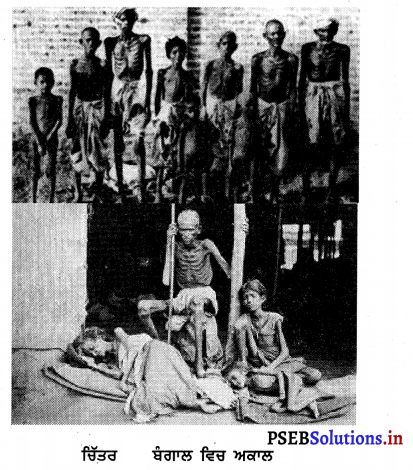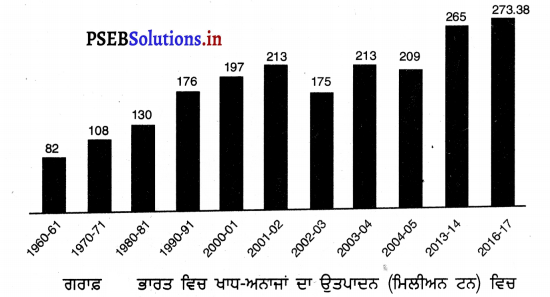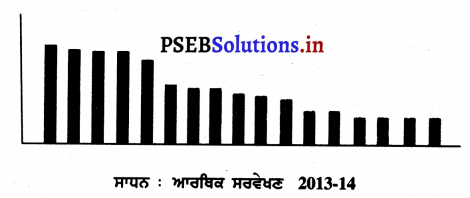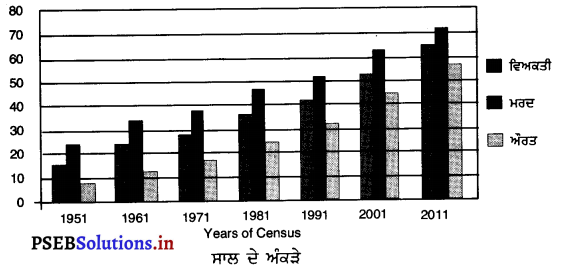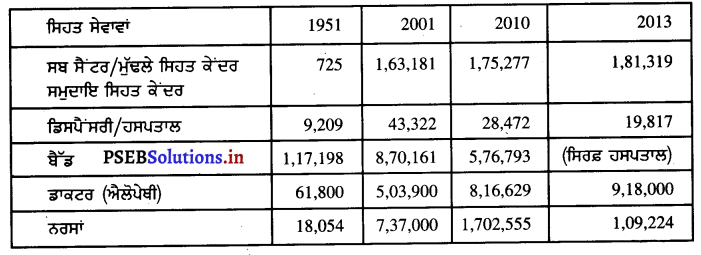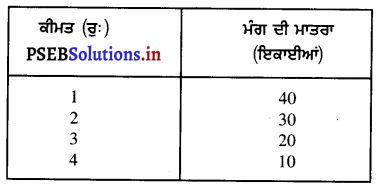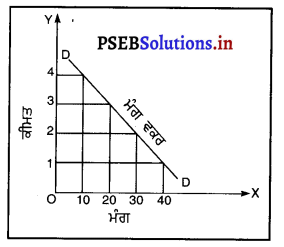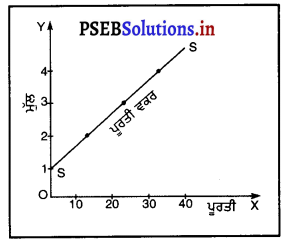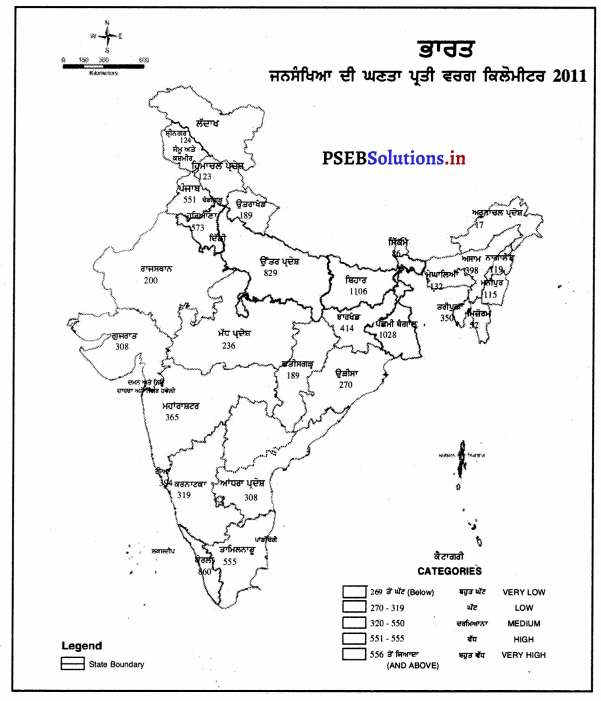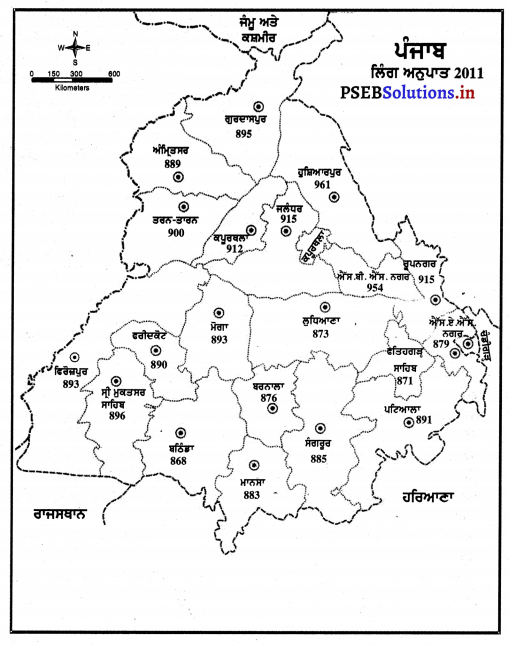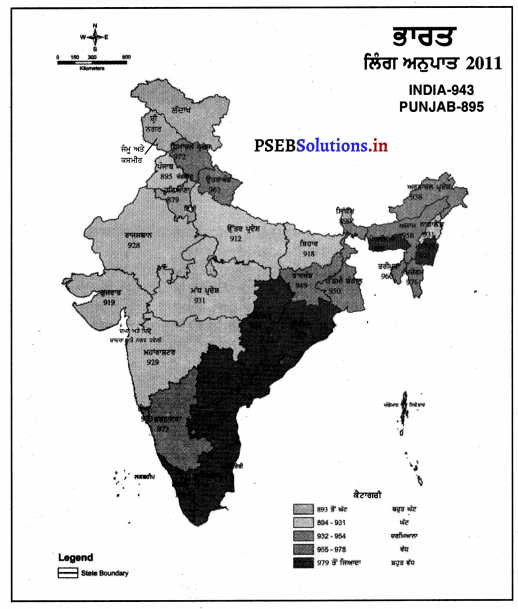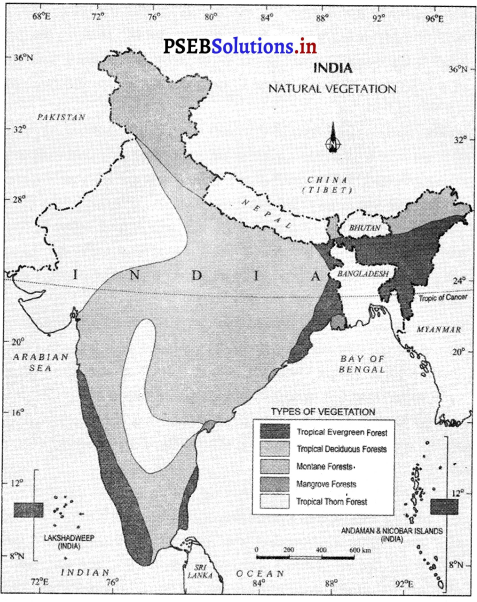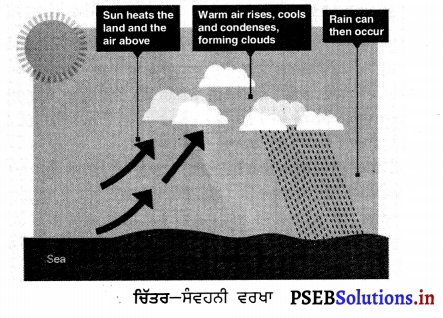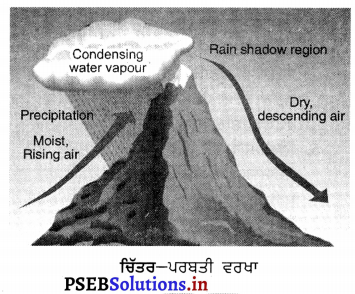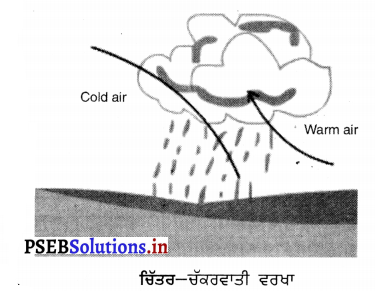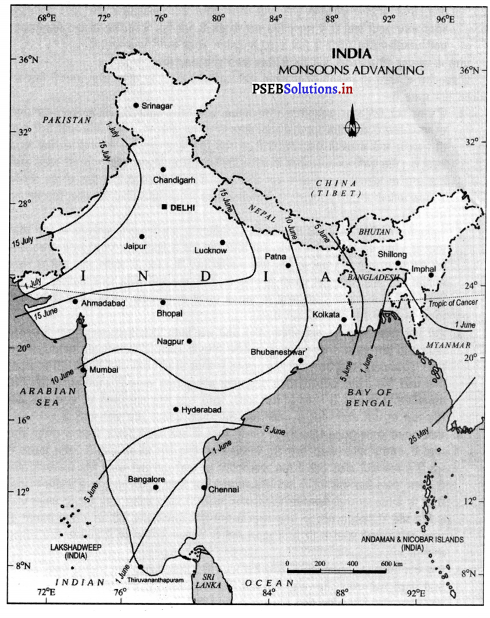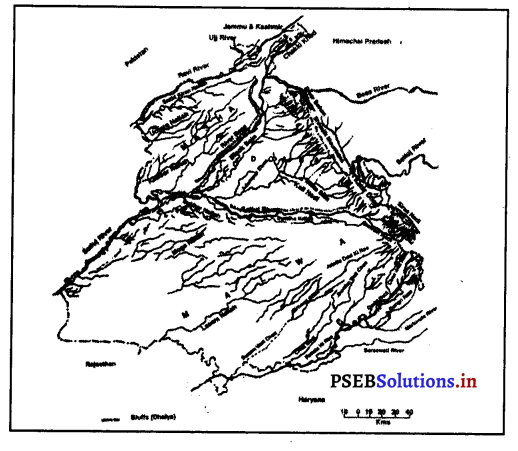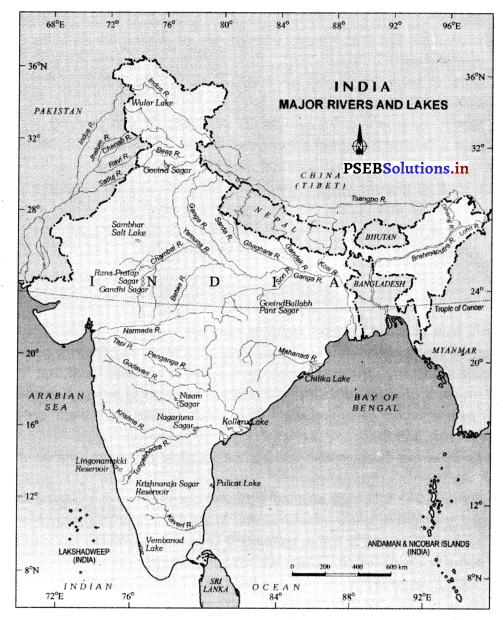Punjab State Board PSEB 9th Class Social Science Book Solutions History Chapter 1 ਪੰਜਾਬ: ਭੂਗੋਲਿਕ ਵਿਸ਼ੇਸ਼ਤਾਵਾਂ ਅਤੇ ਪ੍ਰਭਾਵ Textbook Exercise Questions and Answers.
PSEB Solutions for Class 9 Social Science History Chapter 1 ਪੰਜਾਬ: ਭੂਗੋਲਿਕ ਵਿਸ਼ੇਸ਼ਤਾਵਾਂ ਅਤੇ ਪ੍ਰਭਾਵ
Social Science Guide for Class 9 PSEB ਪੰਜਾਬ: ਭੂਗੋਲਿਕ ਵਿਸ਼ੇਸ਼ਤਾਵਾਂ ਅਤੇ ਪ੍ਰਭਾਵ Textbook Questions and Answers
ਅਭਿਆਸ ਦੇ ਪ੍ਰਸ਼ਨ
(ੳ) ਬਹੁ-ਵਿਕਲਪੀ ਪ੍ਰਸ਼ਨ
ਪ੍ਰਸ਼ਨ 1.
ਰਿਗਵੇਦ ਦੇ ਅਨੁਸਾਰ ਪੰਜਾਬ ਦਾ ਨਾਂ ਕੀ ਸੀ ?
(ਉ) ਹੜੱਪਾ
(ਅ) ਸਪਤ ਸਿੰਧੂ
(ਈ) ਪੰਚਨਦ
(ਸ) ਪੈਂਟਾਪੋਟਾਮੀਆ ।
ਉੱਤਰ-
(ਅ) ਸਪਤ ਸਿੰਧੂ
ਪ੍ਰਸ਼ਨ 2.
ਚੀਨੀ ਯਾਤਰੀ ਕੌਣ ਸੀ ?
(ਉ) ਚਾਣਕਯ
(ਅ) ਲਾਰਡ ਕਰਜ਼ਨ
(ਈ) ਹਿਊਨਸਾਂਗ
(ਸ ਕੋਈ ਵੀ ਨਹੀਂ ।
ਉੱਤਰ-
(ਈ) ਹਿਊਨਸਾਂਗ
ਪ੍ਰਸ਼ਨ 3.
ਪੰਜਾਬ ਨੂੰ ਅੰਗਰੇਜ਼ੀ ਸਾਮਰਾਜ ਵਿਚ ਕਦੋਂ ਮਿਲਾਇਆ ਗਿਆ ?
(ਉ) 1849 ਈ :
(ਅ) 1887 ਈ :
(ਈ) 1889 ਈ :
(ਸ) 1901 ਈ ।
ਉੱਤਰ-
(ਉ) 1849 ਈ :
![]()
ਪ੍ਰਸ਼ਨ 4.
ਇਹ ਦੁਆਬ ਘੱਟ ਉਪਜਾਊ ਹੈ –
(ਉ) ਚੱਜ ਦੁਆਬ
(ਅ) ਸਿੰਧੂ ਸਾਗਰ ਦੁਆਬ
(ਈ) ਰਚਨਾ ਦੁਆਬ
(ਸ) ਬਾਰੀ ਦੁਆਬ ।
ਉੱਤਰ-
(ਅ) ਸਿੰਧੂ ਸਾਗਰ ਦੁਆਬ
ਪ੍ਰਸ਼ਨ 5.
ਘੱਗਰ ਅਤੇ ਜਮੁਨਾ ਦਰਿਆਵਾਂ ਦੇ ਵਿਚਕਾਰ ਦਾ ਖੇਤਰ –
(ਉ) ਮਾਲਵਾ
(ਅ) ਬਾਂਗਰ
(ਈ) ਮਾਝਾ
(ਸ) ਕੋਈ ਵੀ ਨਹੀਂ ।
ਉੱਤਰ-
(ਅ) ਬਾਂਗਰ
ਪ੍ਰਸ਼ਨ 6.
ਮਾਲਵਾ ਖੇਤਰ ਕਿਨ੍ਹਾਂ ਨਦੀਆਂ ਦੇ ਵਿਚਕਾਰ ਹੈ ?
(ੳ) ਸਤਲੁਜ ਅਤੇ ਜਮੁਨਾ ‘
(ਅ) ਸਤਲੁਜ ਅਤੇ ਘੱਗਰ
(ਈ) ਘੱਗਰ ਅਤੇ ਜਮੁਨਾ ।
(ਸ) ਸਤਲੁਜ ਅਤੇ ਬਿਆਸ ॥
ਉੱਤਰ-
(ਅ) ਸਤਲੁਜ ਅਤੇ ਘੱਗਰ
(ਅ) ਖ਼ਾਲੀ ਥਾਂਵਾਂ ਭਰੋ-
ਪ੍ਰਸ਼ਨ 1.
…………. ਸੱਭਿਅਤਾ ਦਾ ਜਨਮ ਪੰਜਾਬ ਵਿੱਚ ਹੋਇਆ ਸੀ ।
ਉੱਤਰ-
ਹੜੱਪਾ,
ਪ੍ਰਸ਼ਨ 2.
‘ਪੈਂਟਾ’ ਦਾ ਅਰਥ………….. ਹੈ ਅਤੇ ‘ਪੋਟਾਮੀਆ` ਦਾ ਅਰਥ. …………… ਹੈ ।
ਉੱਤਰ-
ਪੰਜ; ਨਦੀ,
ਪ੍ਰਸ਼ਨ 3.
ਭੂਗੋਲਿਕ ਦ੍ਰਿਸ਼ਟੀਕੋਣ ਤੋਂ ਪੰਜਾਬ ਨੂੰ………………. ਭਾਗਾਂ ਵਿੱਚ ਵੰਡਿਆ ਗਿਆ ਹੈ ।
ਉੱਤਰ-
ਤਿੰਨ,
ਪ੍ਰਸ਼ਨ 4.
………….ਦਾ ਖੇਤਰ ਚਿਨਾਬ ਅਤੇ ਜੇਹਲਮ ਨਦੀਆਂ ਦੇ ਵਿਚਕਾਰ ਦਾ ਇਲਾਕਾ ਹੈ ।
ਉੱਤਰ-
ਚੱਜ ਦੁਆਬ,
ਪ੍ਰਸ਼ਨ 5.
ਸਿੱਖ ਧਰਮ ਦੇ ਸੰਸਥਾਪਕ…………….ਸਨ ।
ਉੱਤਰ-
ਸ੍ਰੀ ਗੁਰੂ ਨਾਨਕ ਦੇਵ ਜੀ,
ਪ੍ਰਸ਼ਨ 6.
ਭਾਸ਼ਾ ਦੇ ਆਧਾਰ ‘ਤੇ…………….. ਨੂੰ ਪੰਜਾਬ ਦਾ ਪੁਨਰਗਠਨ ਕੀਤਾ ਗਿਆ ।
ਉੱਤਰ-
1 ਨਵੰਬਰ, 1966,
ਪ੍ਰਸ਼ਨ 7.
ਮਾਊਂਟ ਐਵਰੈਸਟ ਦੀ ਉੱਚਾਈ…………… ਮੀਟਰ ਹੈ ।
ਉੱਤਰ-
8848 ਮੀਟਰ ।
(ਈ) ਸਹੀ ਮਿਲਾਨ ਕਰੋ
| (ਉ) | (ਅ) |
| 1.ਰਿਗਵੇਦ | (i) ਉੱਤਰ-ਪੱਛਮੀ ਪਰਬਤ |
| 2. ਸੁਲੇਮਾਨ | (ii) ਸੇਕੀਆ |
| 3. ਬਾਂਗਰ | (iii) ਉਪ-ਪਰਬਤੀ ਖੇਤਰ |
| 4. ਸ਼ਿਵਾਲਿਕ | (iv) ਸਪਤ ਸਿੰਧੂ |
| 5. ਹਿਊਨਸਾਂਗ | (v) ਘੱਗਰ ਅਤੇ ਜਮੁਨਾ । |
ਉੱਤਰ-
| 1. ਰਿਗਵੇਦ | (iv) ਸਪਤ ਸਿੰਧੂ |
| 2. ਸੁਲੇਮਾਨ | (i) ਉੱਤਰ-ਪੱਛਮੀ ਪਰਬਤ |
| 3. ਬਾਂਗਰ | (v) ਘੱਗਰ ਅਤੇ ਜਮੁਨਾ |
| 4. ਸ਼ਿਵਾਲਿਕ | (iii) ਉਪ-ਪਰਬਤੀ ਖੇਤਰ |
| 5. ਹਿਊਨਸਾਂਗ | (ii) ਸੇਕੀਆ | |
(ਸ) ਅੰਤਰ ਦੱਸੋ
ਪ੍ਰਸ਼ਨ 1.
ਮਾਲਵਾ ਅਤੇ ਗਰ
ਉੱਤਰ –
ਮਾਲਵਾ ਅਤੇ ਬਾਂਗਰ –
- ਮਾਲਵਾ-ਸਤਲੁਜ ਅਤੇ ਘੱਗਰ ਨਦੀਆਂ ਦੇ ਵਿਚਕਾਰ ਫੈਲੇ ਦੇਸ਼ ਨੂੰ “ਮਾਲਵਾ’ ਕਹਿੰਦੇ ਹਨ । ਲੁਧਿਆਣਾ, ਪਟਿਆਲਾ, ਨਾਭਾ, ਸੰਗਰੂਰ, ਫ਼ਰੀਦਕੋਟ, ਬਠਿੰਡਾ ਆਦਿ ਪ੍ਰਸਿੱਧ ਸ਼ਹਿਰ ਇਸ ਭਾਗ ਵਿਚ ਸਥਿਤ ਹਨ ।
- ਬਾਂਗਰ ਜਾਂ ਹਰਿਆਣਾ-ਇਹ ਦੇਸ਼ ਘੱਗਰ ਅਤੇ ਜਮਨਾ ਨਦੀਆਂ ਦੇ ਵਿਚਕਾਰ ਸਥਿਤ ਹੈ । ਇਸ ਦੇ ਮੁੱਖ ਨਗਰ | ਅੰਬਾਲਾ, ਕੁਰੂਕਸ਼ੇਤਰ, ਪਾਣੀਪਤ, ਜੀਂਦ, ਰੋਹਤਕ, ਕਰਨਾਲ, ਗੁੜਗਾਵਾਂ ਤੇ ਹਿਸਾਰ ਹਨ | ਇਹ ਭਾਗ ਇਕ ਇਤਿਹਾਸਿਕ ਮੈਦਾਨ ਵੀ ਹੈ ਜਿੱਥੇ ਅਨੇਕਾਂ ਫ਼ੈਸਲਾਕੁੰਨ ਯੁੱਧ ਲੜੇ ਗਏ ।
ਪ੍ਰਸ਼ਨ 2.
ਪੱਛਮੀ ਪੰਜਾਬ ਅਤੇ ਪੂਰਬੀ ਪੰਜਾਬ
ਉੱਤਰ –
- ਪੱਛਮੀ ਪੰਜਾਬ ਅਤੇ ਪੂਰਬੀ ਪੰਜਾਬ-1947 ਈ: ਵਿਚ ਸੁਤੰਤਰਤਾ ਦੇ ਸਮੇਂ ਪੰਜਾਬ ਨੂੰ ਦੋ ਭਾਗਾਂ ਵਿੱਚ ਵੰਡਿਆ ਗਿਆ : ਪੱਛਮੀ ਪੰਜਾਬ ਅਤੇ ਪੂਰਬੀ ਪੰਜਾਬ ਦਾ ਪੱਛਮੀ ਭਾਗ ਮੁਸਲਿਮ ਬਹੁ-ਗਿਣਤੀ ਖੇਤਰ ਸੀ ।
- ਉਹ ਅਲੱਗ ਹੋ ਕੇ ਪੰਜਾਬ : ਭੂਗੋਲਿਕ ਵਿਸ਼ੇਸ਼ਤਾਵਾਂ ਅਤੇ ਪ੍ਰਭਾਵ ਪਾਕਿਸਤਾਨ ਦੇ ਰੂਪ ਵਿਚ ਨਵਾਂ ਦੇਸ਼ ਬਣਿਆ | ਪੂਰਬੀ ਪੰਜਾਬ ਭਾਰਤ ਦਾ ਹਿੱਸਾ ਬਣਿਆ । ਉਸ ਸਮੇਂ ਪੰਜਾਬ ਦੇ 13 ਜ਼ਿਲ੍ਹੇ ਪਾਕਿਸਤਾਨ ਵਿਚ ਚਲੇ ਗਏ ਅਤੇ ਬਾਕੀ 16 ਜ਼ਿਲੇ ਭਾਰਤੀ ਪੰਜਾਬ ਵਿਚ ਰਹਿ ਗਏ ।
ਪ੍ਰਸ਼ਨ 3.
ਦੱਰੇ ਅਤੇ ਦੁਆਬ
ਉੱਤਰ –
ਦੱਰੇ ਅਤੇ ਦੁਆਬ –
- ‘ਦੱਰੇ -ਇਹ ਉੱਚੇ ਪਹਾੜਾਂ ਵਿਚੋਂ ਲੰਘਣ ਲਈ ਕੁਦਰਤ ਦੁਆਰਾ ਬਣਾਏ ਗਏ ਮਾਰਗ ਹੁੰਦੇ ਹਨ । ਇਨ੍ਹਾਂ ਔਖੇ ਮਾਰਗਾਂ ਵਿੱਚੋਂ ਹੋ ਕੇ ਪਰਬਤਾਂ ਨੂੰ ਪਾਰ ਕੀਤਾ ਜਾ ਸਕਦਾ ਹੈ ।
- ‘ਦੁਆਬ -ਦੋ ਨਦੀਆਂ ਦੇ ਵਿਚਕਾਰ ਦੀ ਭੂਮੀ ਨੂੰ ‘ਦੁਆਬ’ ਆਖਦੇ ਹਨ । ਪੰਜਾਬ ਦਾ ਮੈਦਾਨ ਪੰਜ ਦੁਆਬਿਆਂ ਤੋਂ ਬਣਿਆ ਹੈ ।
ਪ੍ਰਸ਼ਨ 4.
ਹਿਮਾਲਿਆ ਅਤੇ ਉਪ-ਪਰਬਤੀ ਖੇਤਰ
ਉੱਤਰ –
ਹਿਮਾਲਾ ਅਤੇ ਉਪ-ਪਰਬਤੀ ਖੇਤਰ (ਤਰਾਈ ਖੇਤਰ) –
- ਹਿਮਾਲਾ-ਹਿਮਾਲਾ ਅਰਥਾਤ ਹਿਮ + ਆਲਯ, ਦਾ ਅਰਥ ਹੈ ਬਰਫ ਦਾ ਘਰ ।ਹਿਮਾਲਾ ਦੀਆਂ ਪਹਾੜੀਆਂ ਪੰਜਾਬ ਵਿਚ ਲੜੀਬੱਧ ਹਨ । ਇਨ੍ਹਾਂ ਪਹਾੜੀਆਂ ਨੂੰ ਉੱਚਾਈ ਦੇ ਅਨੁਸਾਰ ਤਿੰਨ ਭਾਗਾਂ ਵਿਚ ਵੰਡਿਆ ਜਾਂਦਾ ਹੈ । ਮਹਾਨ
ਹਿਮਾਲਾ, ਮੱਧ ਹਿਮਾਲਾ ਅਤੇ ਬਾਹਰੀ ਹਿਮਾਲਾ । - ਉਪ-ਪਰਬਤੀ ਖੇਤਰ (ਤਰਾਈ ਖੇਤਰ)-ਇਹ ਖੇਤਰ ਹਿਮਾਲਾ ਦੀਆਂ ਪੀਰ ਪੰਜਾਲ ਪਹਾੜੀਆਂ ਦੇ ਦੱਖਣ ਵਿੱਚ ਸਥਿਤ ਹੈ । ਇਸ ਵਿੱਚ ਸ਼ਿਵਾਲਿਕ ਅਤੇ ਕਸੌਲੀ ਦੀਆਂ ਪਹਾੜੀਆਂ ਦੇ ਢਲਾਨ ਵਾਲੇ ਪ੍ਰਦੇਸ਼ ਸ਼ਾਮਲ ਹਨ । ਇਸ
ਖੇਤਰ ਦੀਆਂ ਪਹਾੜੀਆਂ ਦੀ ਔਸਤ ਉੱਚਾਈ 1000-3000 ਫੁੱਟ ਹੈ ।
![]()
ਪ੍ਰਸ਼ਨ 5.
ਚੱਜ ਦੁਆਬ ਅਤੇ ਬਿਸਤ ਜਲੰਧਰ ਦੁਆਬ ।
ਉੱਤਰ –
ਚੱਜ ਦੁਆਬ ਅਤੇ ਬਿਸਤ ਜਲੰਧਰ ਦੁਆਬ –
- ‘ਚੱਜ ਦੁਆਬ’ -‘ਚਨਾਬ ਅਤੇ ਜੇਹਲਮ ਨਦੀਆਂ ਦੇ ਵਿਚਕਾਰਲੇ ਖੇਤਰ ਨੂੰ ਚੱਜ ਦੁਆਬ ਦੇ ਨਾਂ ਨਾਲ ਸੱਦਿਆ ਜਾਂਦਾ ਹੈ । ਇਸ ਦੁਆਬ ਦੇ ਪ੍ਰਸਿੱਧ ਸ਼ਹਿਰ ਗੁਜਰਾਤ, ਭੇਰਾ ਅਤੇ ਸ਼ਾਹਪੁਰ ਹਨ ।
- ਬਿਸਤ ਜਲੰਧਰ ਦੁਆਬ-ਇਸ ਦੁਆਬ ਵਿਚ ਸਤਲੁਜ ਅਤੇ ਬਿਆਸ ਨਦੀਆਂ ਦੇ ਵਿਚਕਾਰਲਾ ਦੇਸ਼ ਸ਼ਾਮਿਲ ਹੈ ।
ਇਹ ਦੇਸ਼ ਬੜਾ ਉਪਜਾਊ ਹੈ । ਜਲੰਧਰ ਅਤੇ ਹੁਸ਼ਿਆਰਪੁਰ ਇਸ ਦੁਆਬ ਦੇ ਪ੍ਰਸਿੱਧ ਸ਼ਹਿਰ ਹਨ ।
II. ਬਹੁਤ ਛੋਟੇ ਉੱਤਰਾਂ ਵਾਲੇ ਪ੍ਰਸ਼ਨ
ਪ੍ਰਸ਼ਨ 1.
“ਪੰਜਾਬੀ ਸ਼ਬਦ ਤੋਂ ਕੀ ਭਾਵ ਹੈ ?
ਉੱਤਰ-
ਪੰਜਾਬ ਤੋਂ ਭਾਵ ਪੰਜ ਨਦੀਆਂ ਦੇ ਪ੍ਰਦੇਸ਼ ਤੋਂ ਹੈ । “ਪੰਜਾਬ” ਫ਼ਾਰਸੀ ਦੇ ਦੋ ਸ਼ਬਦਾਂ-ਪੰਜ ਅਤੇ ਆਬ ਦੇ ਮੇਲ ਤੋਂ ਬਣਿਆ ਹੈ । ਪੰਜ ਦਾ ਅਰਥ ਹੈ ਪੰਜ ਅਤੇ ਆਬ ਦਾ ਅਰਥ ਹੈ-ਪਾਣੀ ਅਰਥਾਤ ਨਦੀ ।
ਪ੍ਰਸ਼ਨ 2.
ਯੂਨਾਨੀਆਂ ਨੇ ਪੰਜਾਬ ਦਾ ਕੀ ਨਾਂ ਰੱਖਿਆ ਸੀ ?
ਉੱਤਰ-
“ਯੂਨਾਨੀਆਂ ਨੇ ਪੰਜਾਬ ਦਾ ਨਾਂ ਪੈਂਟਾਪੋਟਾਮੀਆਂ ਅਰਥਾਤ ਪੰਜ ਨਦੀਆਂ ਦੀ ਧਰਤੀ ਰੱਖਿਆ ਸੀ । ਪੈਂਟਾ ਦਾ ਅਰਥ ਹੈ ਪੰਜ ਅਤੇ ਪੋਟਾਮੀਆ ਦਾ ਅਰਥ ਹੈ ਨਦੀ ।
ਪ੍ਰਸ਼ਨ 3.
‘ਸਪਤ ਸਿੰਧੂ ਤੋਂ ਕੀ ਭਾਵ ਹੈ ?
ਉੱਤਰ-
ਵੈਦਿਕ ਕਾਲ ਵਿਚ ਪੰਜਾਬ ਨੂੰ ਸਪਤ ਸਿੰਧੂ ਕਿਹਾ ਜਾਂਦਾ ਸੀ ਕਿਉਂਕਿ ਉਸ ਸਮੇਂ ਇਹ ਸੱਤ ਨਦੀਆਂ ਦਾ ਦੇਸ਼ ਸੀ ।
ਪ੍ਰਸ਼ਨ 4.
1947 ਈ: ਵਿਚ ਪੰਜਾਬ ਨੂੰ ਕਿਹੜੇ ਦੋ ਭਾਗਾਂ ਵਿੱਚ ਵੰਡਿਆ ਗਿਆ ਸੀ ?
ਉੱਤਰ-
1947 ਈ: ਵਿਚ ਪੰਜਾਬ ਨੂੰ ਪੱਛਮੀ ਪੰਜਾਬ ਅਤੇ ਪੂਰਬੀ ਪੰਜਾਬ ਵਿਚ ਵੰਡਿਆ ਗਿਆ ਸੀ । ਪੱਛਮੀ ਹਿੱਸਾ ਪਾਕਿਸਤਾਨ ਬਣਿਆ ਅਤੇ ਪੂਰਬੀ ਹਿੱਸਾ ਭਾਰਤ ਨੂੰ ਮਿਲਿਆ ।
ਪ੍ਰਸ਼ਨ 5.
ਪੰਜਾਬ ਦੀ ਉੱਤਰ-ਪੱਛਮੀ ਸੀਮਾ ਵਿੱਚ ਸਥਿਤ ਕਿਸੇ ਦੋ ਦੱਰਿਆਂ ਦੇ ਨਾਂ ਦੱਸੋ ।
ਉੱਤਰ-
ਪੰਜਾਬ ਦੀ ਉੱਤਰ-ਪੱਛਮੀ ਸੀਮਾ ਵਿਚ ਸਥਿਤ ਦੱਰੇ ਹਨ-ਖੈਬਰ, ਕੁੱਰਮ, ਟੋਚੀ ਆਦਿ ।
ਪ੍ਰਸ਼ਨ 6.
ਪੰਜਾਬ ਨੂੰ ਭਾਸ਼ਾ ਦੇ ਆਧਾਰ ‘ਤੇ ਕਦੋਂ ਅਤੇ ਕਿੰਨੇ ਰਾਜਾਂ ਵਿੱਚ ਵੰਡਿਆ ਗਿਆ ?
ਉੱਤਰ-
ਪੰਜਾਬ ਨੂੰ ਭਾਸ਼ਾ ਦੇ ਆਧਾਰ ‘ਤੇ 1 ਨਵੰਬਰ, 1966 ਈ: ਨੂੰ ਦੋ ਰਾਜਾਂ-ਪੰਜਾਬ ਅਤੇ ਹਰਿਆਣਾ ਵਿਚ ਵੰਡਿਆ ਗਿਆ ।
![]()
III. ਛੋਟੇ ਉੱਤਰਾਂ ਵਾਲੇ ਪ੍ਰਸ਼ਨ
ਪ੍ਰਸ਼ਨ 1.
ਪੰਜਾਬ ਦੇ ਵੱਖ-ਵੱਖ ਇਤਿਹਾਸਕ ਨਾਂਵਾਂ ‘ਤੇ ਚਾਨਣਾ ਪਾਓ ।
ਉੱਤਰ-
ਪੰਜਾਬ ਦੇ ਨਾਂ ਸਮੇਂ-ਸਮੇਂ ‘ਤੇ ਬਦਲਦੇ ਰਹੇ ਹਨ-
- ਵੈਦਿਕ ਕਾਲ ਵਿਚ ਪੰਜਾਬ ਨੂੰ ਸਪਤ ਸਿੰਧੂ ਸੱਤ ਦਰਿਆਵਾਂ ਦੀ ਧਰਤੀ ਕਿਹਾ ਜਾਂਦਾ ਸੀ ।
- ਪ੍ਰਾਚੀਨ ਮਹਾਂਕਾਵਿ ਰਮਾਇਣ, ਮਹਾਂਭਾਰਤ ਅਤੇ ਪੁਰਾਣਾਂ ਵਿੱਚ ਪੰਜਾਬ ਨੂੰ ਪੰਚਨਦ ਦੱਸਿਆ ਗਿਆ ਹੈ ।
- ਯੂਨਾਨੀਆਂ ਨੇ ਪੰਜਾਬ ਨੂੰ ਪੈਂਟਾਪੋਟਾਮੀਆ (Peniapotamia) ਨਾਂ ਰੱਖਿਆ ਸੀ । ਪੈਂਟਾ ਦਾ ਅਰਥ ਹੈ ਪੰਜ ਅਤੇ | ਪੋਟਾਮੀਆ ਦਾ ਅਰਥ ਹੈ-ਨਦੀ ਅਰਥਾਤ ਪੰਜ ਦਰਿਆਵਾਂ ਨਦੀਆਂ ਦੀ ਧਰਤੀ ।
- ਟਕ ਕਬੀਲੇ ਨੇ ਪੰਜਾਬ ਨੂੰ ਟਕ ਦੇਸ਼ ਜਾਂ ਟਕੀ ਦਾ ਨਾਂ ਦਿੱਤਾ ।
- ਚੀਨੀ ਯਾਤਰੀ ਹਿਊਨਸਾਂਗ ਨੇ ਪੰਜਾਬ ਨੂੰ ਸੇਕੀਆ ਕਹਿ ਕੇ ਬੁਲਾਇਆ ।
- ਮਹਾਰਾਜਾ ਰਣਜੀਤ ਸਿੰਘ ਦੇ ਸਮੇਂ ਪੰਜਾਬ ਲਾਹੌਰ ਸੂਬਾ ਦੇ ਨਾਂ ਨਾਲ ਜਾਣਿਆ ਜਾਣ ਲੱਗਾ ।
- ਮੁਗਲ ਬਾਦਸ਼ਾਹ ਅਕਬਰ ਨੇ ਪੰਜਾਬ ਨੂੰ ਪੰਜਾਬ ਦਾ ਨਾਂ ਦਿੱਤਾ ਪੰਜਾਬ ਫ਼ਾਰਸੀ ਭਾਸ਼ਾ ਵਿੱਚ ਪੰਜ ਅਤੇ ਆਬ ਤੋਂ ਮਿਲ ਕੇ ਬਣਿਆ ਹੈ । ਪੰਜ ਦਾ ਅਰਥ ਹੈ ਪੰਜ ਅਤੇ ਆਬ ਦਾ ਅਰਥ ਹੈ ਪਾਣੀ ।
- 1849 ਈ: ਵਿਚ ਅੰਗਰੇਜ਼ਾਂ ਨੇ ਇਸਨੂੰ ਆਪਣੇ ਰਾਜ ਵਿਚ ਮਿਲਾ ਲਿਆ ਅਤੇ ਇਸਨੂੰ ਪੰਜਾਬ ਪ੍ਰਾਂਤ ਦਾ ਨਾਂ ਦਿੱਤਾ ।
- 1947 ਈ: ਵਿਚ ਭਾਰਤ-ਪਾਕਿਸਤਾਨ ਵੰਡ ਵਿਚ ਪੰਜਾਬ ਪੂਰਬੀ ਅਤੇ ਪੱਛਮੀ ਪੰਜਾਬ ਨਾਂ ਦੇ ਦੋ ਭਾਗਾਂ ਵਿਚ ਵੰਡਿਆ ਗਿਆ, ਪਰ ਦੋਨਾਂ ਹੀ ਦੇਸ਼ਾਂ ਵਿਚ ਅੱਜ ਵੀ ਇਸਨੂੰ ਪੰਜਾਬ ਦੇ ਨਾਂ ਨਾਲ ਜਾਣਿਆ ਜਾਂਦਾ ਹੈ ।
ਪ੍ਰਸ਼ਨ 2.
ਪੰਜਾਬ ਦੇ ਇਤਿਹਾਸ ਦਾ ਅਧਿਐਨ ਕਰਨ ਲਈ ਪੰਜਾਬ ਦੀਆਂ ਭੂਗੋਲਿਕ ਵਿਸ਼ੇਸ਼ਤਾਵਾਂ ਦਾ ਅਧਿਐਨ ਕਿਉਂ ਜ਼ਰੂਰੀ ਹੈ ?
ਉੱਤਰ-
ਕਿਸੇ ਵੀ ਦੇਸ਼ ਦਾ ਇਤਿਹਾਸ ਉੱਥੇ ਦੇ ਭੂਗੋਲ ਦੀ ਦੇਣ ਹੁੰਦਾ ਹੈ । ਇਸ ਲਈ ਕਿਸੇ ਦੇਸ਼ ਦੇ ਇਤਿਹਾਸ ਦਾ ਅਧਿਐਨ ਕਰਨ ਲਈ ਉਸ ਦੇਸ਼ ਦੀਆਂ ਭੂਗੋਲਿਕ ਅਵਸਥਾਵਾਂ ਦਾ ਅਧਿਐਨ ਜ਼ਰੂਰੀ ਹੈ । ਪੰਜਾਬ ਦੇ ਰਹਿਣ ਸਹਿਣ, ਖਾਣਪੀਣ, ਪਹਿਰਾਵਾ, ਲੋਕਾਂ ਦੇ ਸੁਭਾਅ ਅਤੇ ਵਿਚਾਰ ਸ਼ਕਤੀ ਕਾਫ਼ੀ ਸੀਮਾ ਤਕ ਭੂਗੋਲਿਕ ਤੱਥਾਂ ਦੁਆਰਾ ਪ੍ਰਭਾਵਿਤ ਹੋਈ ਹੈ । ਇੱਥੋਂ ਦੀ ਹਰੇਕ ਘਟਨਾ ਇੱਥੋਂ ਦੇ ਕਿਸੇ ਨਾ ਕਿਸੇ ਭੂਗੋਲਿਕ ਤੱਥ ਨਾਲ ਜੁੜੀ ਹੋਈ ਹੈ । ਇੱਥੋਂ ਦਾ ਉਪਜਾਊ ਮੈਦਾਨ ਸੱਭਿਅਤਾ ਦਾ ਘੜਾ ਬਣਿਆ | ਸਮਾਂ ਪੈਣ ਤੇ ਇਹੀ ਮੈਦਾਨ ਰਣਭੂਮੀ ਬਣਿਆ ਅਤੇ ਇੱਥੋਂ ਦੇ ਲੱਖਾਂ ਵੀਰਾਂ ਨੇ ਆਪਣੇ ਪਾਣੀ ਦਾ ਬਲਿਦਾਨ ਦਿੱਤਾ । ਇੱਥੋਂ ਦੀਆਂ ਨਦੀਆਂ ਨੇ ਅਨੇਕ ਵਾਰ ਹਮਲਾਵਰਾਂ ਦਾ ਮਾਰਗ ਦਰਸ਼ਨ ਕੀਤਾ । ਇੱਥੋਂ ਦੇ ਜੰਗਲਾਂ ਦਾ ਮਹੱਤਵ ਵੀ ਕੁੱਝ ਘੱਟ ਨਹੀਂ ਹੈ । ਮੁਗ਼ਲ ਅੱਤਿਆਚਾਰਾਂ ਤੋਂ ਪੀੜਿਤ ਪੰਜਾਬ ਦੇ ਲੋਕਾਂ ਨੂੰ ਇਨ੍ਹਾਂ ਹੀ ਜੰਗਲਾਂ ਨੇ ਅਨੇਕ ਵਾਰ ਆਸਰਾ ਦਿੱਤਾ । ਇੱਥੋਂ ਦੇ ਖੁਸ਼ਹਾਲ ਮੈਦਾਨਾਂ ਨੇ ਹਮਲਾਵਰਾਂ ਨੂੰ ਹਮਲਾ ਕਰਨ ਦੀ ਪ੍ਰੇਰਨਾ ਦਿੱਤੀ । ਇਸ ਤਰ੍ਹਾਂ ਪੰਜਾਬ ਦੇ ਭੂਗੋਲ ਨੇ ਪੰਜਾਬ ਨੂੰ ਰੰਗ-ਭੂਮੀ ਅਤੇ ਰਣਭੂਮੀ ਦੋਨਾਂ ਦਾ ਪੱਧਰ ਪ੍ਰਦਾਨ ਕੀਤਾ।
ਪ੍ਰਸ਼ਨ 3.
ਪੰਜਾਬ ਨੂੰ ਭਾਰਤ ਦਾ ਪ੍ਰਵੇਸ਼ ਦੁਆਰ ਕਿਉਂ ਕਿਹਾ ਜਾਂਦਾ ਹੈ ?
ਉੱਤਰ-
ਹਿਮਾਲਾ ਦੀਆਂ ਪੱਛਮੀ ਸ਼ਾਖਾਵਾਂ ਦੇ ਕਾਰਨ ਪੰਜਾਬ ਸਾਲਾਂ ਤੱਕ ਭਾਰਤ ਦੇ ਪ੍ਰਵੇਸ਼ ਦੁਆਰ ਦਾ ਕੰਮ ਕਰਦਾ ਹੈ। ਇਨ੍ਹਾਂ ਪਰਬਤ ਸ਼੍ਰੇਣੀਆਂ ਵਿਚ ਸਥਿਤ ਦਰਿਆਂ ਤੋਂ ਗੁਜ਼ਰਨਾ ਕਠਿਨ ਨਹੀਂ ਹੈ । ਦੂਜੇ ਬੋਲਾਨ ਦੱਰੇ ਦੇ ਇਲਾਵਾ ਸਾਰੇ ਦੌਰੇ ਅਫ਼ਗਾਨਿਸਤਾਨ ਨੂੰ ਪੰਜਾਬ ਨਾਲ ਮਿਲਾਉਂਦੇ ਹਨ । ਇਸ ਲਈ ਆਰੀਆਂ ਤੋਂ ਲੈ ਕੇ ਮੰਗੋਲਾਂ ਤਕ ਸਾਰੇ ਹਮਲਾਵਰ ਇਨ੍ਹਾਂ ਮਾਰਗਾਂ ਦੁਆਰਾ ਭਾਰਤ ‘ਤੇ ਹਮਲਾ ਕਰਦੇ ਰਹੇ ਕਿਉਂਕਿ ਦੱਰੇ ਉਨ੍ਹਾਂ ਨੂੰ ਸਿੱਧਾ, ਪੰਜਾਬ ਦੀ ਧਰਤੀ ‘ਤੇ ਪਹੁੰਚਾ ਦਿੰਦੇ ਸਨ । ਸਭ ਤੋਂ ਪਹਿਲਾਂ ਉਨ੍ਹਾਂ ਨੂੰ ਪੰਜਾਬ ਦੇ ਲੋਕਾਂ ਨਾਲ ਸੰਘਰਸ਼ ਕਰਨਾ ਪਿਆ । ਉਨ੍ਹਾਂ ਨੂੰ ਹਰਾਉਣ ਤੇ ਹੀ ਉਹ ਪੂਰਵ ਵੱਲ ਅੱਗੇ ਵੱਧ ਸਕੇ । ਇਸ ਤਰ੍ਹਾਂ ਪੰਜਾਬ ਭਾਰਤ ਲਈ ਪ੍ਰਵੇਸ਼ ਦੁਆਰ ਦੀ ਭੂਮਿਕਾ ਨਿਭਾਉਂਦਾ ਰਿਹਾ ਹੈ ।
ਪ੍ਰਸ਼ਨ 4.
ਪੰਜਾਬ ਵਿਚ ਇਸਲਾਮ ਧਰਮ ਦਾ ਪ੍ਰਸਾਰ ਤੇਜ਼ੀ ਨਾਲ ਕਿਉਂ ਹੋਇਆ ?
ਉੱਤਰ-
ਪੰਜਾਬ ਵਿਚ ਇਸਲਾਮ ਧਰਮ ਦਾ ਪ੍ਰਸਾਰ ਤੇਜ਼ੀ ਨਾਲ ਹੋਇਆ ਕਿਉਂਕਿ ਸਾਰੇ ਹਮਲਾਵਰ ਪਹਿਲਾਂ ਪੰਜਾਬ ਵਿਚ ਆ ਕੇ ਵਸੇ । ਉਨ੍ਹਾਂ ਨੇ ਇੱਥੇ ਦੇ ਲੋਕਾਂ ਨੂੰ ਇਸਲਾਮ ਧਰਮ ਸਵੀਕਾਰ ਕਰਨ ਲਈ ਮਜ਼ਬੂਰ ਕੀਤਾ। ਮੁਸਲਿਮ ਧਰਮ ਪ੍ਰਚਾਰਕ, ਸੂਫ਼ੀ ਸੰਤਾਂ ਅਤੇ ਵਪਾਰੀਆਂ ਨੇ ਵੀ ਇਸ ਕੰਮ ਵਿਚ ਮਹੱਤਵਪੂਰਨ ਭੂਮਿਕਾ ਨਿਭਾਈ । ਹਿੰਦੂ ਧਰਮ ਦੇ ਕਠੋਰ ਰੀਤੀ-ਰਿਵਾਜ਼ਾਂ ਤੋਂ ਤੰਗ ਆ ਚੁੱਕੇ ਲੋਕਾਂ ਨੇ ਅਸਾਨੀ ਨਾਲ ਇਸਲਾਮ ਧਰਮ ਨੂੰ ਅਪਣਾ ਲਿਆ | ਪਰਿਣਾਮ ਸਵਰੂਪ ਪੰਜਾਬ ਵਿਚ ਇਸਲਾਮ ਧਰਮ ਕਾਫ਼ੀ ਤੇਜ਼ੀ ਨਾਲ ਫੈਲਿਆ ।
![]()
ਪ੍ਰਸ਼ਨ 5.
ਪੰਜਾਬ ਦੀ ਭੂਗੋਲਿਕ ਸਥਿਤੀ ਦਾ ਲੋਕਾਂ ਦੀ ਆਰਥਿਕ ਸਥਿਤੀ ‘ਤੇ ਕੀ ਪ੍ਰਭਾਵ ਪਿਆ ?
ਉੱਤਰ-
ਪੰਜਾਬ ਦੀ ਭੂਗੋਲਿਕ ਸਥਿਤੀ ਨੇ ਇੱਥੋਂ ਦੇ ਲੋਕਾਂ ਦੇ ਜੀਵਨ ਨੂੰ ਆਰਥਿਕ ਤੌਰ ‘ਤੇ ਦ੍ਰਿੜ੍ਹਤਾ ਪ੍ਰਦਾਨ ਕੀਤੀ । ਹਿਮਾਲਾ ਦੀਆਂ ਨਦੀਆਂ ਹਰ ਸਾਲ ਨਵੀਂ ਮਿੱਟੀ ਲਿਆ ਕੇ ਪੰਜਾਬ ਦੇ ਮੈਦਾਨਾਂ ਵਿਚ ਵਿਛਾਉਂਦੀਆਂ ਰਹੀਆਂ । ਸਿੱਟੇ ਵਜੋਂ ਪੰਜਾਬ ਦਾ ਮੈਦਾਨ ਉਪਜਾਊ ਮੈਦਾਨਾਂ ਵਿਚ ਗਿਣਿਆ ਜਾਣ ਲੱਗਾ । ਉਪਜਾਊ ਭੂਮੀ ਕਾਰਨ ਇੱਥੇ ਚੰਗੀ ਫ਼ਸਲ ਹੁੰਦੀ ਰਹੀ ਅਤੇ ਇੱਥੋਂ ਦੇ ਲੋਕ ਖੁਸ਼ਹਾਲ ਹੁੰਦੇ ਗਏ । ਇਨ੍ਹਾਂ ਨਦੀਆਂ ਤੋਂ ਪੰਜਾਬ ਦੀ ਭੂਮੀ ਸਿੰਜੀ ਵੀ ਜਾਂਦੀ ਸੀ । ਬਰਫ਼ ਨਾਲ ਢਕੇ ਰਹਿਣ ਦੇ ਕਾਰਨ ਹਿਮਾਲਾ ਤੋਂ ਨਿਕਲਣ ਵਾਲੀਆਂ ਨਦੀਆਂ ਸਾਰਾ ਸਾਲ ਵਹਿੰਦੀਆਂ ਰਹਿੰਦੀਆਂ ਹਨ ਅਤੇ ਖੇਤੀਬਾੜੀ ਲਈ ਵਰਦਾਨ ਸਿੱਧ ਹੋਈਆਂ ਹਨ ।
ਹਿਮਾਲਾ ਤੋਂ ਪ੍ਰਾਪਤ ਲੱਕੜੀ ਦੇ ਕਾਰਨ ਪੰਜਾਬ ਵਿਚ ਫ਼ਰਨੀਚਰ ਅਤੇ ਖੇਡ ਦਾ ਸਮਾਨ ਬਣਨ ਲੱਗਾ । ਇਨ੍ਹਾਂ ਪਰਬਤਾਂ ਤੋਂ ਪੰਜਾਬ ਦੇ ਲੋਕਾਂ ਨੂੰ ਗੰਦਾ ਬਿਰੋਜਾ, ਜੜ੍ਹੀਆਂ-ਬੂਟੀਆਂ ਅਤੇ ਅਨੇਕ ਵਸਤਾਂ ਉਪਯੋਗੀ ਪ੍ਰਾਪਤ ਹੁੰਦੀਆਂ ਰਹੀਆਂ, ਜਿਸ ਨਾਲ ਪੰਜਾਬ ਵਿਚ ਉਦਯੋਗਾਂ ਦਾ ਵਿਕਾਸ ਹੋਇਆ ।
IV. ਵਡੇ ਉੱਤਰਾਂ ਵਾਲੇ ਪ੍ਰਸ਼ਨ ਦਾ
ਪ੍ਰਸ਼ਨ 1.
ਪੰਜਾਬ ਦੀਆਂ ਭੂਗੋਲਿਕ ਵਿਸ਼ੇਸ਼ਤਾਵਾਂ ਦਾ ਵਰਣਨ ਕਰੋ ।
ਪੰਜਾਬ ਦੇ ਉਪ-ਪਰਬਤੀ (ਤਰਾਈ) ਦੇਸ਼ ਦੇ ਬਾਰੇ ਵਿਚ ਲਿਖੋ ।
ਜਾਂ ਪੰਜਾਬ ਦੇ ਮੈਦਾਨੀ ਖੇਤਰ ਅਤੇ ਭੌਤਿਕ ਵਿਸ਼ੇਸ਼ਤਾਵਾਂ ‘ਤੇ ਇਕ ਨੋਟ ਲਿਖੋ ।
ਉੱਤਰ-
ਭੂਗੋਲਿਕ ਤੌਰ ‘ਤੇ ਪੰਜਾਬ ਦਾ ਅਧਿਐਨ ਬਹੁਤ ਹੀ ਰੋਚਕ ਹੈ । ਇਸ ਨਜ਼ਰੀਏ ਤੋਂ ਪੰਜਾਬ ਨੂੰ ਤਿੰਨ ਭਾਗਾਂ ਵਿਚ ਵੰਡਿਆ ਜਾ ਸਕਦਾ ਹੈ ।
- ਹਿਮਾਲਾ ਅਤੇ ਉਸ ਦੀਆਂ ਉੱਤਰ-ਪੱਛਮੀ ਪਹਾੜੀਆਂ .
- ਤਰਾਈ ਦੇਸ਼ ਜਾਂ ਉਪ-ਪਰਬਤੀ ਖੇਤਰ
- ਮੈਦਾਨੀ ਖੇਤਰ ।
1. ਹਿਮਾਲਾ ਅਤੇ ਉਸ ਦੀਆਂ ਉੱਤਰ-ਪੱਛਮੀ ਪਹਾੜੀਆਂ-ਹਿਮਾਲਿਆ ਅਰਥਾਤ, ਹਿਮ + ਆਲਿਆ ਦਾ ਅਰਥ ਹੈਬਰਫ਼ ਦਾ ਘਰ | ਭਾਰਤ ਦੇ ਉੱਤਰ ਵਿਚ ਸਥਿਤ ਇਹ ਉੱਚਾ ਪਰਬਤ ਸਾਲ ਵਿਚ ਜ਼ਿਆਦਾਤਰ ਸਮੇਂ ਬਰਫ਼ ਨਾਲ ਢੱਕਿਆ ਰਹਿੰਦਾ ਹੈ | ਪੱਛਮ ਤੋਂ ਪੂਰਬ ਦੇ ਵੱਲ ਇਸਦੀ ਲੰਬਾਈ ਲਗਭਗ 2400 ਕਿ.ਮੀ. ਅਤੇ ਉੱਤਰ ਤੋਂ ਦੱਖਣ ਦੇ ਵੱਲ ਔਸਤ ਚੌੜਾਈ ਲਗਭਗ 2500 ਕਿ.ਮੀ. ਹੈ । ਸੰਸਾਰ ਦੀ ਸਭ ਤੋਂ ਉੱਚੀ ਪਰਬਤ ਚੋਟੀ ਮਾਊਂਟ ਐਵਰੈਸਟ (8848 ਮੀ.) ਹਿਮਾਲਿਆ ਵਿਚ ਹੀ ਸਥਿਤ ਹੈ, ਪਰੰਤੁ ਹਿਮਾਲਿਆ ਦੀਆਂ ਸਾਰੀਆਂ ਪਹਾੜੀਆਂ ਦੀ ਉੱਚਾਈ ਇਕ ਸਮਾਨ ਨਹੀਂ ਹੈ । ਇਨ੍ਹਾਂ ਪਹਾੜੀਆਂ ਨੂੰ ਉੱਚਾਈ ਦੇ ਅਨੁਸਾਰ ਤਿੰਨ ਭਾਗਾਂ ਵਿਚ ਵੰਡਿਆ ਜਾਂਦਾ ਹੈ-ਮਹਾਨ ਹਿਮਾਲਾ, ਮੱਧ ਹਿਮਾਲਾ ਅਤੇ ਬਾਹਰੀ ਹਿਮਾਲਾ | | ਪੰਜਾਬ ਦੇ ਉੱਤਰ-ਪੱਛਮ ਵਿਚ ਹਿਮਾਲਿਆ ਦੀਆਂ ਪੱਛਮੀ ਪਹਾੜੀਆਂ ਸਥਿਤ ਹਨ । ਇਨ੍ਹਾਂ ਪਹਾੜੀਆਂ ਵਿਚ ਕਿਰਥਾਰ ਅਤੇ ਸੁਲੇਮਾਨ ਦੀਆਂ ਪਹਾੜੀ ਲੜੀਆਂ ਸ਼ਾਮਲ ਹਨ । ਇਨ੍ਹਾਂ ਪਰਬਤਾਂ ਦੀ ਉਚਾਈ ਵਧੇਰੇ ਨਹੀਂ ਹੈ । ਇਨ੍ਹਾਂ ਦੀ ਸਭ ਤੋਂ ਵੱਡੀ ਵਿਸ਼ੇਸ਼ਤਾ ਇਹ ਹੈ ਕਿ ਇਨ੍ਹਾਂ ਵਿਚ ਅਨੇਕਾਂ ਦੱਰੇ ਹਨ । ਇਨ੍ਹਾਂ ਦੱਰਿਆਂ ਵਿਚ ਖੈਬਰ ਦਾ ਦੱਰਾ ਬਹੁਤ ਮਹੱਤਵਪੂਰਨ ਸਥਾਨ ਰੱਖਦਾ ਹੈ । ਜ਼ਿਆਦਾਤਰ ਹਮਲਾਵਰਾਂ ਦੇ ਲਈ ਇਹੀ ਦੱਰਾ ਪ੍ਰਵੇਸ਼ ਦੁਆਰ ਬਣਿਆ ਰਿਹਾ |
2. ਰਾਈ ਦੇਸ਼ ਜਾਂ ਉਪ-ਪਰਬਤੀ ਖੇਤਰ-ਹਿਮਾਲਾ ਦੇਸ਼ ਦੇ ਉੱਚ ਪ੍ਰਦੇਸ਼ਾਂ ਅਤੇ ਪੰਜਾਬ ਦੇ ਮੈਦਾਨੀ ਦੇਸ਼ਾਂ ਦੇ ਵਿਚਕਾਰ ਤਰਾਈ ਦਾ ਪ੍ਰਦੇਸ਼ ਸਥਿਤ ਹੈ । ਇਸਨੂੰ ਉਪ-ਪਰਬਤੀ ਪ੍ਰਦੇਸ਼ ਵੀ ਕਿਹਾ ਜਾਂਦਾ ਹੈ । ਇਹ 160 ਕਿ. ਮੀਟਰ ਤੋਂ 320 ਕਿ. ਮੀਟਰ ਤਕ ਚੌੜਾ ਹੈ ਅਤੇ ਇਸਦੀ ਉੱਚਾਈ 300 ਤੋਂ 900 ਮੀਟਰ ਤਕ ਹੈ । ਇਹ ਭਾਗ ਅਨੇਕ ਘਾਟੀਆਂ ਕਾਰਨ ਹਿਮਾਲਾ ਪਰਬਤ ਸ਼੍ਰੇਣੀਆਂ ਤੋਂ ਅਲੱਗ ਜਿਹਾ ਦਿਖਾਈ ਦਿੰਦਾ ਹੈ । ਇਸ ਭਾਗ ਵਿਚ ਸਿਆਲਕੋਟ, ਕਾਂਗੜਾ, ਹੁਸ਼ਿਆਰਪੁਰ, ਗੁਰਦਾਸਪੁਰ, ਅੰਬਾਲਾ ਦਾ ਕੁੱਝ ਖੇਤਰ ਸ਼ਾਮਲ ਹੈ । ਆਮ ਤੌਰ ‘ਤੇ ਇਹ ਇਕ ਪਰਬਤੀ ਦੇਸ਼ ਹੈ । ਇਸ ਲਈ ਇੱਥੇ ਉਪਜ ਬਹੁਤ ਘੱਟ ਹੁੰਦੀ ਹੈ । ਵਰਖਾ ਕਾਰਨ ਇੱਥੇ ਅਨੇਕ ਰੋਗ ਫੈਲਦੇ ਹਨ । ਜਿੱਥੇ ਕਿੱਤੇ ਭੂਮੀ ਨੂੰ ਖੇਤੀ ਯੋਗ ਬਣਾਇਆ ਗਿਆ ਹੈ ਉੱਥੇ ਆਲੂ, ਚੌਲ, ਅਨਾਜ ਅਤੇ ਮੱਕਾ ਦੀ ਖੇਤੀ ਕੀਤੀ ਜਾਣ ਲੱਗੀ ਹੈ । ਇੱਥੇ ਆਉਣ-ਜਾਣ ਦੇ ਸਾਧਨਾਂ ਦਾ ਵੀ ਪੂਰੀ ਤਰ੍ਹਾਂ ਨਾਲ ਵਿਕਾਸ ਨਹੀਂ ਹੋ ਪਾਇਆ ਹੈ । ਇੱਥੋਂ ਦੀ ਜਨਸੰਖਿਆ ਘੱਟ ਹੈ । ਇੱਥੋਂ ਦੇ ਲੋਕਾਂ ਨੂੰ ਆਪਣਾ ਜੀਵਨ-ਨਿਰਵਾਹ ਕਰਨ ਲਈ ਸਖ਼ਤ ਮਿਹਨਤ ਕਰਨੀ ਪੈਂਦੀ ਹੈ । ਕੁਦਰਤ ਦੀ ਸੁੰਦਰ ਛਵੀ ਦੇ ਕਾਰਨ ਇਹ ਦੇਸ਼ ਬਹੁਤ ਹੀ ਆਕਰਸ਼ਣ ਹੈ ਅਤੇ ਜੰਗਲਾਂ ਨਾਲ ਢਕੀਆਂ ਇਸਦੀਆਂ ਘਾਟੀਆਂ ਮਨਮੋਹਕ ਦ੍ਰਿਸ਼ ਪੇਸ਼ ਕਰਦੀਆਂ ਹਨ ।
3. ਮੈਦਾਨੀ ਖੇਤਰ-ਪੰਜਾਬ ਦੇ ਮੈਦਾਨੀ ਖੇਤਰ ਨੂੰ ਦੋ ਭਾਗਾਂ ਵਿਚ ਵੰਡਿਆ ਗਿਆ ਹੈ-ਪੂਰਬੀ ਮੈਦਾਨ ਅਤੇ ਪੱਛਮੀ ਮੈਦਾਨ । ਜਮਨਾ ਅਤੇ ਰਾਵੀ ਨਦੀ ਦੇ ਵਿਚਕਾਰਲੇ ਭਾਗ ਨੂੰ ਪੂਰਬੀ ਮੈਦਾਨ ਕਹਿੰਦੇ ਹਨ । ਇਹ ਦੇਸ਼ ਜ਼ਿਆਦਾ ਉਪਜਾਊ ਹੈ । ਇੱਥੋਂ ਦੀ ਵਸੋਂ ਵੀ ਸੰਘਣੀ ਹੈ । ਰਾਵੀ ਅਤੇ ਸਿੰਧ ਦੇ ਵਿਚਕਾਰਲੇ ਭਾਗ ਨੂੰ ਪੱਛਮੀ ਮੈਦਾਨ ਕਹਿੰਦੇ ਹਨ । ਇਹ ਦੇਸ਼ ਪੂਰਬੀ ਮੈਦਾਨ ਦੀ ਤੁਲਨਾ ਵਿਚ ਘੱਟ ਖ਼ੁਸ਼ਹਾਲ ਹੈ । ਪੰਜ ਦੁਆਬ-ਦੋ ਨਦੀਆਂ ਦੇ ਵਿਚਕਾਰ ਦੀ ਭੂਮੀ ਨੂੰ ਦੁਆਬ ਕਹਿੰਦੇ ਹਨ ।
ਪੰਜਾਬ ਦਾ ਮੈਦਾਨੀ ਭਾਗ ਹੇਠ ਲਿਖੇ ਦੁਆਬਿਆਂ ਨਾਲ ਘਿਰਿਆ ਹੋਇਆ ਹੈ ।
1. ਸਿੰਧ ਸਾਗਰ ਦੁਆਬ-ਜੇਹਲਮ ਅਤੇ ਸਿੰਧ ਨਦੀਆਂ ਦੇ ਵਿਚਕਾਰ ਦੇ ਦੇਸ਼ ਨੂੰ ਸਿੰਧ ਸਾਗਰ ਦੁਆਬ ਕਿਹਾ ਜਾਂਦਾ ਹੈ । ਇਹ ਦੇਸ਼ ਵਧੇਰੇ ਉਪਜਾਊ ਨਹੀਂ ਹੈ । ਜੇਹਲਮ ਅਤੇ ਰਾਵਲਪਿੰਡੀ ਇੱਥੋਂ ਦੇ ਪ੍ਰਸਿੱਧ ਸ਼ਹਿਰ ਹਨ ।
2. ਰਚਨਾ ਦੁਆਬ-ਇਸ ਭਾਗ ਵਿਚ ਰਾਵੀ ਅਤੇ ਚਨਾਬ ਨਦੀਆਂ ਦੇ ਵਿਚਕਾਰਲਾ ਇਲਾਕਾ ਸ਼ਾਮਲ ਹੈ, ਜੋ ਕਾਫ਼ੀ | ਉਪਜਾਊ ਹੈ । ਗੁਜਰਾਂਵਾਲਾ ਅਤੇ ਸ਼ੇਖੂਪੁਰਾ ਇਸ ਦੁਆਬ ਦੇ ਪ੍ਰਸਿੱਧ ਨਗਰ ਹਨ ।
3. ਬਿਸਤ ਜਲੰਧਰ ਦੁਆਬ-ਇਸ ਦੁਆਬ ਵਿਚ ਸਤਲੁਜ ਅਤੇ ਬਿਆਸ ਨਦੀਆਂ ਦੇ ਵਿਚਕਾਰਲਾ ਦੇਸ਼ ਸ਼ਾਮਲ ਹੈ । ਇਹ ਦੇਸ਼ ਬੜਾ ਉਪਜਾਊ ਹੈ । ਜਲੰਧਰ ਅਤੇ ਹੁਸ਼ਿਆਰਪੁਰ ਇਸ ਦੁਆਬ ਦੇ ਪ੍ਰਸਿੱਧ ਸ਼ਹਿਰ ਹਨ ।
4. ਬਾਰੀ ਦੁਆਬ-ਬਿਆਸ ਅਤੇ ਰਾਵੀ ਨਦੀਆਂ ਦੇ ਵਿਚਕਾਰ ਦੇ ਇਲਾਕੇ ਨੂੰ ਬਾਰੀ ਦੁਆਬ ਕਿਹਾ ਜਾਂਦਾ ਹੈ । ਇਹ | ਅਤਿਅੰਤ ਉਪਜਾਉ ਖੇਤਰ ਹੈ । ਪੰਜਾਬ ਦੇ ਵਿਚਕਾਰ ਸਥਿਤ ਹੋਣ ਦੇ ਕਾਰਨ ਇਸ ਨੂੰ ਮਾਝਾ ਵੀ ਕਿਹਾ ਜਾਂਦਾ ਹੈ । ਪੰਜਾਬ ਦੇ ਦੋ ਪ੍ਰਸਿੱਧ ਨਗਰ ਲਾਹੌਰ ਅਤੇ ਅੰਮ੍ਰਿਤਸਰ ਇਸੇ ਦੁਆਬੇ ਵਿਚ ਸਥਿਤ ਹਨ ।
5. ਚੱਜ ਦੁਆਬਚਨਾਬ ਅਤੇ ਜੇਹਲਮ ਨਦੀਆਂ ਦੇ ਵਿਚਕਾਰਲੇ ਖੇਤਰ ਨੂੰ ਚੱਜ ਦੁਆਬ ਦੇ ਨਾਂ ਨਾਲ ਸੱਦਿਆ ਜਾਂਦਾ ਹੈ । ਇਸ ਦੁਆਬ ਦੇ ਪ੍ਰਸਿੱਧ ਸ਼ਹਿਰ ਗੁਜਰਾਤ, ਭੇਰਾ ਅਤੇ ਸ਼ਾਹਪੁਰ ਹਨ । ਮਾਲਵਾ ਅਤੇ ਬਾਂਗਰ-ਪੰਜ ਦੁਆਬਿਆਂ ਤੋਂ ਇਲਾਵਾ ਪੰਜਾਬ ਦੇ ਮੈਦਾਨੀ ਭਾਗ ਵਿਚ ਸਤਲੁਜ ਅਤੇ ਜਮਨਾ ਦੇ ਵਿਚਕਾਰ ਦਾ ਵਿਸ਼ਾਲ ਮੈਦਾਨੀ ਖੇਤਰ ਵੀ ਸ਼ਾਮਲ ਹੈ ।
ਇਸ ਨੂੰ ਦੋ ਭਾਗਾਂ ਵਿਚ ਵੰਡਿਆ ਜਾ ਸਕਦਾ ਹੈ-ਮਾਲਵਾ ਅਤੇ ਬਾਂਗਰ ।
1. ਮਾਲਵਾ-ਸਤਲੁਜ ਅਤੇ ਘੱਗਰ ਨਦੀਆਂ ਦੇ ਵਿਚਕਾਰ ਫੈਲੇ ਦੇਸ਼ ਨੂੰ “ਮਾਲਵਾ’ ਕਹਿੰਦੇ ਹਨ । ਲੁਧਿਆਣਾ, ਪਟਿਆਲਾ, ਨਾਭਾ, ਸੰਗਰੂਰ, ਫ਼ਰੀਦਕੋਟ, ਬਠਿੰਡਾ ਆਦਿ ਪ੍ਰਸਿੱਧ ਸ਼ਹਿਰ ਇਸ ਭਾਗ ਵਿਚ ਸਥਿਤ ਹਨ ।
2. ਬਾਂਗਰ ਜਾਂ ਹਰਿਆਣਾ-ਇਹ ਦੇਸ਼ ਘੱਗਰ ਅਤੇ ਜਮਨਾ ਨਦੀਆਂ ਦੇ ਵਿਚਕਾਰ ਸਥਿਤ ਹੈ ਇਸ ਦੇ ਮੁੱਖ ਨਗਰ ਅੰਬਾਲਾ, ਕੁਰੂਕਸ਼ੇਤਰ, ਪਾਣੀਪਤ, ਜੀਂਦ, ਰੋਹਤਕ, ਕਰਨਾਲ, ਗੁੜਗਾਵਾਂ ਤੇ ਹਿਸਾਰ ਹਨ । ਇਹ ਭਾਗ ਇਕ ਇਤਿਹਾਸਿਕ ਮੈਦਾਨ ਵੀ ਹੈ ਜਿੱਥੇ ਅਨੇਕਾਂ ਫ਼ੈਸਲਾਕੁੰਨ ਯੁੱਧ ਲੜੇ ਗਏ ।
ਪ੍ਰਸ਼ਨ 2.
ਪੰਜਾਬ ਦੀ ਭੂਗੋਲਿਕ ਸਥਿਤੀ ਨੇ ਪੰਜਾਬ ਦੇ ਰਾਜਨੀਤਿਕ ਅਤੇ ਧਾਰਮਿਕ ਖੇਤਰ ਦੇ ਇਤਿਹਾਸ ‘ਤੇ ਕੀ ਪ੍ਰਭਾਵ ਪਾਇਆ ? ਵਿਸਥਾਰ ਸਹਿਤ ਲਿਖੋ ।
ਉੱਤਰ-
ਪੰਜਾਬ ਭਾਰਤ ਦੇ ਉੱਤਰ-ਪੱਛਮ ਵਿਚ ਸਥਿਤ ਇਕ ਅਤਿ ਉਪਜਾਉ ਦੇਸ਼ ਹੈ । ਇਸਦੀ ਆਦਰਸ਼ ਸਥਿਤੀ ਨੇ ਇੱਥੋਂ ਦੇ ਇਤਿਹਾਸ ਨੂੰ ਇਕ ਵਿਸ਼ੇਸ਼ ਰੂਪ ਪ੍ਰਦਾਨ ਕੀਤਾ ਹੈ । ਉਂਝ ਵੀ ਕਿਸੇ ਦੇਸ਼ ਦਾ ਇਤਿਹਾਸ ਉੱਥੋਂ ਦੇ ਭੂਗੋਲ ਦੀ ਕੁੱਖ ਤੋਂ ਹੀ ਜਨਮ ਲੈਂਦਾ ਹੈ । ਪੰਜਾਬ ਦਾ ਇਤਿਹਾਸ ਵੀ ਕੋਈ ਅਪਵਾਦ ਨਹੀਂ ਹੈ । ਇੱਥੋਂ ਦੇ ਲੋਕਾਂ ਨੇ ਰਾਜਨੀਤੀ ਤੇ ਧਾਰਮਿਕ ਖੇਤਰ ਵਿੱਚ ਮਹੱਤਵਪੂਰਨ ਸਫ਼ਲਤਾ ਪ੍ਰਾਪਤ ਕੀਤੀ ਹੈ । ਸੰਖੇਪ ਵਿੱਚ ਪੰਜਾਬ ਦੀ ਸਥਿਤੀ ਨੇ ਪੰਜਾਬ ਦੇ ਇਤਿਹਾਸ ਨੂੰ ਹੇਠ ਲਿਖੇ ਰੰਗਾਂ ਵਿਚ ਰੰਗਿਆ ਹੈ –
1. ਰਾਜਨੀਤਿਕ ਖੇਤਰ ‘ਤੇ ਪ੍ਰਭਾਵ-
- ਪੰਜਾਬ ਦੇ ਉੱਤਰ-ਪੱਛਮ ਵਿਚ ਸਥਿਤ ਦੱਰੇ ਹਮਲਾਵਰਾਂ ਦੇ ਲਈ ਪ੍ਰਵੇਸ਼ ਦਵਾਰ ਦਾ ਕੰਮ ਕਰਦੇ ਸਨ ।
- ਸਾਰੇ ਮੁੱਢਲੇ ਹਮਲਾਵਰ ਉੱਤਰ-ਪੱਛਮ ਦੀ ਦਿਸ਼ਾ ਤੋਂ ਪੰਜਾਬ ਵਿਚ ਪ੍ਰਵੇਸ਼ ਕਰਦੇ ਰਹੇ ।
2. ਉਨ੍ਹਾਂ ਦਾ ਸਾਹਮਣਾ ਕਰਨ ਲਈ ਪੰਜਾਬ ਦੇ ਵੀਰ ਸਪੂਤ ਅੱਗੇ ਵੱਧੇ । ਸਾਰੇ ਮਹੱਤਵਪੂਰਨ ਅਤੇ ਫੈਸਲਾਕੁੰਨ ਯੁੱਧ ਇਸੇ ਧਰਤੀ ‘ਤੇ ਹੀ ਲੜੇ ਗਏ ।
ਚੰਦਰਗੁਪਤ ਮੌਰੀਆ ਨੇ ਭਾਰਤ ਵਿਚ ਪਹਿਲਾ ਵਿਸ਼ਾਲ ਸਾਮਰਾਜ ਕਾਇਮ ਕੀਤਾ ਸੀ, ਪਰ ਉਸਦੇ ਸਾਮਰਾਜ ਦੀ ਨੀਂਹ ਪੰਜਾਬ ਤੋਂ ਹੀ ਪਈ ।
3. ਪੰਜਾਬ ਦੇ ਵਣਾਂ ਅਤੇ ਪਰਬਤਾਂ ਨੇ ਸਿੱਖਾ ਨੂੰ ਸੰਕਟ ਦੇ ਸਮੇਂ ਸ਼ਰਨ ਦਿੱਤੀ । ਇੱਥੇ ਹੀ ਰਹਿ ਕੇ ਸਿੱਖਾਂ ਨੇ ਗੁਰੀਲਾ ਯੁੱਧ ਪ੍ਰਣਾਲੀ ਦੁਆਰਾ ਅਤੇ ਅਹਿਮਦਸ਼ਾਹ ਅਬਦਾਲੀ ਦੇ ਦੰਦ ਖੱਟੇ ਕੀਤੇ ।
4. ਅੰਗਰੇਜ਼ ਪੰਜਾਬ ‘ਤੇ ਸਭ ਤੋਂ ਅਖ਼ੀਰ ਵਿਚ ਅਧਿਕਾਰ ਕਰ ਸਕੇ । ਇਸਦਾ ਕਾਰਨ ਇਹ ਸੀ ਕਿ ਉਨ੍ਹਾਂ ਨੇ ਦੇਸ਼ ਦੇ ਪੂਰਬੀ ਤੱਟ ਤੋਂ ਭਾਰਤ ਵਿਚ ਪ੍ਰਵੇਸ਼ ਕੀਤਾ ਸੀ । ਇਹ ਦੇਸ਼ ਪੰਜਾਬ ਤੋਂ ਬਹੁਤ ਦੂਰ ਸੀ ।
2. ਧਾਰਮਿਕ ਖੇਤਰ ‘ਤੇ ਪ੍ਰਭਾਵ-ਧਾਰਮਿਕ ਖੇਤਰ ਵਿਚ ਪੰਜਾਬ ਦੀ ਭੂਗੋਲਿਕ ਸਥਿਤੀ ਨੇ ਇੱਥੋਂ ਦੇ ਇਤਿਹਾਸ ‘ਤੇ | ਹੇਠਾਂ ਲਿਖੇ ਪ੍ਰਭਾਵ ਪਾਏ –
(1) ਵੈਦਿਕ ਧਰਮ ਦਾ ਜਨਮ ਅਤੇ ਵਿਕਾਸ-ਵੈਦਿਕ ਧਰਮ ਦਾ ਆਰੰਭ ਵੇਦਾਂ ਤੋਂ ਮੰਨਿਆ ਜਾਂਦਾ ਹੈ । ਵੇਦ ਚਾਰ ਹਨ ਰਿਗਵੇਦ, ਸਾਮਵੇਦ, ਅਰਥਵੇਦ, ਅਜੁਰਵੇਦ । ਇਨ੍ਹਾਂ ਵਿਚੋਂ ਰਿਗਵੇਦ, ਸਭ ਤੋਂ ਪ੍ਰਾਚੀਨ ਅਤੇ ਸਰਵ-ਉੱਚ ਹੈ । ਇਸ ਦੀ ਰਚਨਾ ਪੰਜਾਬ ਦੀ ਧਰਤੀ ‘ਤੇ ਹੀ ਹੋਈ ਹੈ । ਇਸ ਤਰ੍ਹਾਂ ਇਹ ਪੰਜਾਬ ਵੈਦਿਕ ਧਰਮ ਦੇ ਪ੍ਰਚਾਰ ਦਾ ਕੇਂਦਰ ਰਿਹਾ ਹੈ ।
(2) ਇਸਲਾਮ ਧਰਮ ਦਾ ਪ੍ਰਸਾਰ-ਇਸਲਾਮ ਧਰਮ ਦਾ ਜਨਮ ਮੱਕਾ-ਮਦੀਨਾ ਵਿਚ ਹੋਇਆ ਅਤੇ ਤੇਜ਼ੀ ਨਾਲ ਮੱਧ ਏਸ਼ੀਆ ਦੇ ਦੇਸ਼ਾਂ ਵਿਚ ਫੈਲ ਗਿਆ । ਇਨ੍ਹਾਂ ਦੇਸ਼ਾਂ ਤੋਂ ਮੁਸਲਿਮ ਹਮਲਾਵਰ, ਧਰਮ ‘ਪ੍ਰਚਾਰਕ, ਵਪਾਰੀ, ਸੂਫ਼ੀ ਸੰਤ ਆਦਿ ਉੱਤਰ-ਪੱਛਮੀ ਦੱਰਿਆਂ ਦੇ ਰਸਤੇ ਭਾਰਤ ਆਏ । ਮੁਸਲਿਮ ਹਮਲਾਵਰਾਂ ਨੇ ਪੰਜਾਬ ‘ਤੇ ਆਪਣਾ ਅਧਿਕਾਰ ਕਰ ਲਿਆ ਅਤੇ ਇੱਥੋਂ ਦੇ ਲੋਕਾਂ ਨੂੰ ਇਸਲਾਮ ਧਰਮ ਅਪਣਾਉਣ ਲਈ ਮਜ਼ਬੂਰ ਕੀਤਾ । ਇਸਦੇ ਇਲਾਵਾ ਹਿੰਦੂ ਸਮਾਜ ਵਿਚ ਪ੍ਰਚਲਿਤ ਕਠੋਰ ਰੀਤੀ-ਰਿਵਾਜ਼ਾਂ ਅਤੇ ਜਾਤੀ-ਭੇਦ-ਭਾਵ ਦੇ ਕਾਰਨ ਨੀਵੀਆਂ ਜਾਤਾਂ ਦੇ ਬਹੁਤ ਸਾਰੇ ਲੋਕਾਂ ਨੇ ਇਸਲਾਮ ਧਰਮ ਅਪਣਾ ਲਿਆ । ਇਸ ਤਰ੍ਹਾਂ ਪੰਜਾਬ ਵਿਚ ਇਸਲਾਮ ਧਰਮ ਦਾ ਕਾਫ਼ੀ ਤੇਜ਼ੀ ਨਾਲ ਪ੍ਰਸਾਰ ਹੋਇਆ ।
(3) ਸਿੱਖ ਧਰਮ ਦਾ ਉਦੈ ਅਤੇ ਵਿਕਾਸ-ਵਿਦੇਸ਼ੀ ਹਮਲਾਵਰਾਂ ਦੇ ਕਾਰਨ ਪੰਜਾਬ ਦੇ ਲੋਕਾਂ ‘ਤੇ ਕਈ ਤਰ੍ਹਾਂ ਦੇ ਅੱਤਿਆਚਾਰ ਹੋਏ । ਉਸ ਸਮੇਂ ਹਿੰਦੂ ਸਮਾਜ ਜਾਤੀ ਭੇਦ, ਕਰਮ-ਕਾਂਡਾਂ ਅਤੇ ਪਾਖੰਡਾਂ ਵਿਚ ਫਸ ਚੁੱਕਿਆ ਸੀ । ਇਸ ਤਰ੍ਹਾਂ ਲੋਕਾਂ ਦਾ ਜੀਵਨ ਅਤਿਅੰਤ ਦਰਦਮਈ ਹੋ ਗਿਆ ਸੀ । ਇਸ ਤਰ੍ਹਾਂ ਦੇ ਵਾਤਾਵਰਨ ਵਿਚ ਪੰਜਾਬ ਦੀ ਧਰਤੀ ‘ਤੇ ਇਕ ਮਹਾਨ ਕ੍ਰਾਂਤੀਕਾਰੀ ਮਹਾਂਪੁਰਖ ਸ੍ਰੀ ਗੁਰੂ ਨਾਨਕ ਦੇਵ ਜੀ ਨੇ ਜਨਮ ਲਿਆ । ਉਨ੍ਹਾਂ ਨੇ ਪ੍ਰਚਲਿਤ | ਜਾਤੀ ਭੇਦ, ਕਰਮ-ਕਾਂਡਾਂ, ਪਾਖੰਡਾਂ ਅਤੇ ਰਾਜਨੀਤਿਕ ਅੱਤਿਆਚਾਰਾਂ ਦਾ ਵਿਰੋਧ ਕੀਤਾ । ਉਨ੍ਹਾਂ ਨੇ ਸੰਸਾਰ ਨੂੰ ਸਭ ਦੇ ਕਲਿਆਣ (ਸਰਬਤ ਦਾ ਭਲਾ) ਦਾ ਸੰਦੇਸ਼ ਦਿੱਤਾ ਜਿਸਨੇ ਸਿੱਖ ਧਰਮ ਦੀ ਨੀਂਹ ਪਾਈ । ਸ੍ਰੀ ਗੁਰੂ ਨਾਨਕ ਦੇਵ ਜੀ ਦੇ ਬਾਅਦ ਨੌਂ ਗੁਰੂਆਂ ਨੇ ਸਿੱਖ ਧਰਮ ਦੇ ਪ੍ਰਚਾਰ ਅਤੇ ਪ੍ਰਸਾਰ ਵਿਚ ਆਪਣਾ ਯੋਗਦਾਨ ਦਿੱਤਾ | ਅੱਤਿਆਚਾਰਾਂ ਦੇ ਵਿਰੁੱਧ ਅਤੇ ਧਰਮ ਦੀ ਰੱਖਿਆ ਦੇ ਲਈ ਨੌਂ ਸਿੱਖ ਗੁਰੂਆਂ ਨੇ ਆਪਣੇ ਬਲਿਦਾਨ ਵੀ ਦਿੱਤੇ । ਪਰਿਣਾਮ ਸਵਰੂਪ ਪੰਜਾਬ ਵਿਚ ਸਿੱਖ ਧਰਮ ਤੇਜ਼ੀ ਨਾਲ ਵਿਕਸਿਤ ਹੋਇਆ ।
![]()
ਪ੍ਰਸ਼ਨ 3.
ਵਿਦੇਸ਼ੀ ਹਮਲਿਆਂ ਦਾ ਪੰਜਾਬ ਦੇ ਲੋਕਾਂ ਦੇ ਜੀਵਨ ‘ਤੇ ਕੀ ਪ੍ਰਭਾਵ ਪਿਆ ?
ਉੱਤਰ-
ਵਿਦੇਸ਼ੀ ਹਮਲਿਆਂ ਦੇ ਪੰਜਾਬ ਦੇ ਲੋਕਾਂ ਦੇ ਜੀਵਨ ‘ਤੇ ਬੁਰੇ ਅਤੇ ਚੰਗੇ ਦੋਵਾਂ ਤਰ੍ਹਾਂ ਦੇ ਪ੍ਰਭਾਵ ਪਏ । ਇਨ੍ਹਾਂ ਦਾ ਅਲੱਗ-ਅਲੱਗ ਵਰਣਨ ਇਸ ਤਰ੍ਹਾਂ ਹੈ । ਬੁਰੇ ਪ੍ਰਭਾਵ –
- ਅੱਤਿਆਚਾਰ-ਵਿਦੇਸ਼ੀ ਹਮਲਾਵਰਾਂ ਨੇ ਪੰਜਾਬ ਦੇ ਲੋਕਾਂ ‘ਤੇ ਅਨੇਕ ਅੱਤਿਆਚਾਰ ਕੀਤੇ । ਮੁਸਲਿਮ ਹਮਲਾਵਰਾਂ ਨੇ ਉਨ੍ਹਾਂ ਨੂੰ ਇਸਲਾਮ ਕਬੂਲ ਕਰਨ ਦੇ ਲਈ ਮਜ਼ਬੂਰ ਕੀਤਾ । ਉਨ੍ਹਾਂ ਨੇ ਇਹ ਕੰਮ ਤਲਵਾਰ ਦੇ ਬਲ ‘ਤੇ ਕਰਨ ਦਾ ਯਤਨ ਕੀਤਾ |
- ਜਨ-ਧਨ ਦੀ ਹਾਨੀ-ਵਿਦੇਸ਼ੀ ਹਮਲਿਆਂ ਨਾਲ ਪੰਜਾਬ ਦੇ ਲੋਕਾਂ ਨੂੰ ਜਨ-ਧਨ ਦੀ ਭਾਰੀ ਹਾਨੀ ਉਠਾਣੀ ਪਈ । ਇਨ੍ਹਾਂ ਹਮਲਿਆਂ ਵਿਚ ਕਈ ਲੋਕ ਮਾਰੇ ਗਏ ਅਤੇ ਖੇਤੀ ਉਜੜ ਗਈ । ‘
- ਕਲਾ ਅਤੇ ਸਾਹਿਤ ਦੇ ਵਿਕਾਸ ਵਿਚ ਰੁਕਾਵਟ-ਪੰਜਾਬ ਪ੍ਰਾਚੀਨ ਸਭਿਅਤਾ ਅਤੇ ਸੰਸਕ੍ਰਿਤੀ ਦਾ ਪਲਨਾ ਸੀ । ਇੱਥੇ ਦੀ ਕਲਾ ਅਤੇ ਸਾਹਿਤ ਕਾਫ਼ੀ ਵਿਕਸਿਤ ਸੀ । ਵਿਦੇਸ਼ੀ ਹਮਲਿਆਂ ਨਾਲ ਇਨ੍ਹਾਂ ਦੇ ਵਿਕਾਸ ਵਿਚ ਰੁਕਾਵਟ ਪਈ । ਕਈ ਗੰਥ ਅਤੇ ਕਲਾਂ-ਕ੍ਰਿਤੀਆਂ ਨਸ਼ਟ ਹੋ ਗਈਆਂ ।
ਚੰਗੇ ਪ੍ਰਭਾਵ –
- ਪੰਜਾਬੀਆਂ ਦੇ ਵਿਸ਼ੇਸ਼ ਗੁਣ-ਲਗਾਤਾਰ ਯੁੱਧਾਂ ਵਿਚ ਉਲਝੇ ਰਹਿਣ ਦੇ ਕਾਰਨ ਪੰਜਾਬ ਦੇ ਲੋਕਾਂ ਵਿਚ ਵੀਰਤਾ, ਸਾਹਸ, ਮਿਹਨਤ ਅਤੇ ਚੰਗੇ ਗੁਣ ਉਤਪੰਨ ਹੋਏ । ਅੱਜ ਵੀ ਪੰਜਾਬ ਦੇ ਲੋਕਾਂ ਵਿਚ ਇਹ ਗੁਣ ਮੌਜੂਦ ਹਨ ।
- ਵਿਕਸਿਤ ਮਿਸ਼ਰਿਤ ਸੰਸਕ੍ਰਿਤੀ ਦਾ ਵਿਕਾਸ-ਵਿਦੇਸ਼ੀਆਂ ਦੇ ਸੰਪਰਕ ਵਿਚ ਰਹਿਣ ਦੇ ਨਾਲ ਪੰਜਾਬ ਵਿਚ ਇਕ ਮਿਸ਼ਰਿਤ ਸੰਸਕ੍ਰਿਤੀ ਦਾ ਵਿਕਾਸ ਹੋਇਆ ਪੰਜਾਬੀਆਂ ਦੇ ਖਾਣ-ਪੀਣ, ਪਹਿਰਾਵੇ ਅਤੇ ਰਹਿਣ-ਸਹਿਣ ਵਿਚ ਕਈ ਨਵੇਂ ਮੁੱਲ ਜੁੜ ਗਏ । ਇਸ ਤਰ੍ਹਾਂ ਪੰਜਾਬ ਦੀ ਵਿਸ਼ੇਸ਼ ਸੰਸਕ੍ਰਿਤੀ ਕਾਫ਼ੀ ਵਿਕਸਿਤ ਹੋ ਗਈ । ਸੱਚ ਤਾਂ ਇਹ ਹੈ ਕਿ ਵਿਦੇਸ਼ੀ ਹਮਲਿਆਂ ਨੇ ਪੰਜਾਬ ਅਤੇ ਪੰਜਾਬੀਆਂ ਦੇ ਚਰਿੱਤਰ ਨੂੰ ਇਕ ਨਵਾਂ ਰੂਪ ਪ੍ਰਦਾਨ ਕੀਤਾ ।
PSEB 9th Class Social Science Guide ਪੰਜਾਬ: ਭੂਗੋਲਿਕ ਵਿਸ਼ੇਸ਼ਤਾਵਾਂ ਅਤੇ ਪ੍ਰਭਾਵ Important Questions and Answers
ਵਸਤੁਨਿਸ਼ਠ ਪ੍ਰਸ਼ਨ ਅਤੇ
I. ਬਹੁ-ਵਿਕਲਪੀ ਪ੍ਰਸ਼ਨ
ਪ੍ਰਸ਼ਨ 1.
ਪੰਜਾਬ ਵਿਚ ਪਹਿਲੇ ਸਿੱਖ ਰਾਜ ਦੀ ਸਥਾਪਨਾ ਕੀਤੀ –
(ੳ) ਸ੍ਰੀ ਗੁਰੂ ਨਾਨਕ ਦੇਵ ਜੀ ਨੇ
(ਅ) ਮਹਾਰਾਜਾ ਰਣਜੀਤ ਸਿੰਘ ਨੇ
(ਈ) ਬੰਦਾ ਸਿੰਘ ਬਹਾਦਰ ਨੇ
(ਸ) ਗੁਰੂ ਗੋਬਿੰਦ ਸਿੰਘ ਜੀ ਨੇ ।
ਉੱਤਰ-
(ਅ) ਮਹਾਰਾਜਾ ਰਣਜੀਤ ਸਿੰਘ ਨੇ
ਪ੍ਰਸ਼ਨ 2.
ਪੰਜਾਬ ਨੂੰ ਭਾਸ਼ਾ ਦੇ ਆਧਾਰ ‘ਤੇ ਦੋ ਹਿੱਸਿਆਂ ਵਿਚ ਵੰਡਿਆ ਗਿਆ –
(ਉ) 1947 ਈ: ਵਿਚ
(ਅ) 1966 ਈ: ਵਿਚ
(ਈ) 1950 ਈ: ਵਿਚ
(ਸ) 1971 ਈ: ਵਿਚ ।
ਉੱਤਰ-
(ਅ) 1966 ਈ: ਵਿਚ
ਪ੍ਰਸ਼ਨ 3.
ਅੰਗਰੇਜ਼ਾਂ ਅਤੇ ਮਹਾਰਾਜਾ ਰਣਜੀਤ ਸਿੰਘ ਦਰਮਿਆਨ ਸੀਖਾ ਦਾ ਕੰਮ ਕਰਦਾ ਸੀ –
(ੳ) ਸਤਲੁਜ ਦਰਿਆ
(ਅ) ਚਿਨਾਬ ਦਰਿਆ ।
(ਈ) ਰਾਵੀ ਦਰਿਆ
(ਸ) ਬਿਆਸ ਦਰਿਆ ।
ਉੱਤਰ-
(ੳ) ਸਤਲੁਜ ਦਰਿਆ
ਪ੍ਰਸ਼ਨ 4.
ਅੱਜ-ਕਲ੍ਹ ਹਿੰਦ-ਪਾਕ ਸੀਮਾ ਦਾ ਕੰਮ ਕਿਹੜਾ ਦਰਿਆ ਕਰਦਾ ਹੈ ?
(ੳ) ਰਾਵੀ ਦਰਿਆ
(ਅ) ਚਿਨਾਬ ਦਰਿਆ
(ਈ) ਬਿਆਸ ਦਰਿਆ
(ਸ) ਸਤਲੁਜ ਦਰਿਆ ।
ਉੱਤਰ-
(ੳ) ਰਾਵੀ ਦਰਿਆ
![]()
ਪ੍ਰਸ਼ਨ 5.
ਸ਼ਾਹ ਜ਼ਮਾਨ ਨੇ ਭਾਰਤ (ਪੰਜਾਬ) ਉੱਤੇ ਹਮਲਾ ਕੀਤਾ –
(ਉ) 1811 ਈ: ਵਿਚ
(ਅ) 1798 ਈ: ਵਿਚ
(ਈ) 1757 ਈ: ਵਿਚ
(ਸ) 1794 ਈ: ਵਿਚ ।
ਉੱਤਰ-
(ਅ) 1798 ਈ: ਵਿਚ
ਪ੍ਰਸ਼ਨ 6.
ਦਿੱਲੀ ਨੂੰ ਭਾਰਤ ਦੀ ਰਾਜਧਾਨੀ ਬਣਾਇਆ
(ਉ) ਲਾਰਡ ਵਿਲੀਅਮ ਬੈਂਟਿੰਕ ਨੇ
(ਅ) ਲਾਰਡ ਮਾਊਂਟਬੈਟਨ ਨੇ
(ਈ) ਲਾਰਡ ਹਾਰਡਿੰਗ ਨੇ
(ਸ) ਲਾਰਡ ਕਰਜ਼ਨ ਨੇ ।
ਉੱਤਰ-
(ਈ) ਲਾਰਡ ਹਾਰਡਿੰਗ ਨੇ
II. ਖ਼ਾਲੀ ਥਾਂਵਾਂ ਭਰੋ –
ਪ੍ਰਸ਼ਨ 1.
ਪੰਜਾਬ ਨੂੰ………… ਕਾਲ ਵਿਚ ਸਪਤ ਸਿੰਧੂ ਕਿਹਾ ਜਾਂਦਾ ਸੀ ।
ਉੱਤਰ-
ਵੈਦਿਕ
ਪ੍ਰਸ਼ਨ 2.
ਦੋ ਦਰਿਆਵਾਂ ਦੇ ਵਿਚਕਾਰਲੇ ਹਿੱਸੇ ਨੂੰ………. ਕਹਿੰਦੇ ਹਨ ।
ਉੱਤਰ-
ਦੁਆਬਾ,
ਪ੍ਰਸ਼ਨ 3.
ਮੁਗ਼ਲ ਸ਼ਾਸਕ ਅਕਬਰ ਨੇ ਪੰਜਾਬ ਨੂੰ………….ਪਾਂਤਾਂ ਵਿਚ ਵੰਡਿਆ ।
ਉੱਤਰ-
ਦੋ,
ਪ੍ਰਸ਼ਨ 4.
ਮਹਾਰਾਜਾ ਰਣਜੀਤ ਸਿੰਘ ਦੇ ਅਧੀਨ ਪੰਜਾਬ ਨੂੰ……………ਰਾਜ ਦੇ ਨਾਂ ਨਾਲ ਸੱਦਿਆ ਜਾਣ ਲੱਗਾ |
ਉੱਤਰ-
ਲਾਹੌਰ,
ਪ੍ਰਸ਼ਨ 5.
ਰਮਾਇਣ ਅਤੇ ਮਹਾਂਭਾਰਤ ਕਾਲ ਵਿਚ ਪੰਜਾਬ ਨੂੰ………. ਕਿਹਾ ਜਾਂਦਾ ਸੀ ।
ਉੱਤਰ-
ਸੇਕੀਆ,
ਪ੍ਰਸ਼ਨ 6.
ਸਿਕੰਦਰ ਨੇ ਭਾਰਤ ‘ਤੇ………ਈ: ਵਿਚ ਹਮਲਾ ਕੀਤਾ ।
ਉੱਤਰ-
326.
III. ਸਹੀ ਮਿਲਾਨ ਕਰੋ
| (ਉ) | (ਅ) |
| 1. ਮਹਾਰਾਜਾ ਰਣਜੀਤ ਸਿੰਘ | (i) ਸਤਲੁਜ ਅਤੇ ਬਿਆਸ |
| 2. ਪੰਜਾਬ ਦਾ ਅੰਗਰੇਜ਼ੀ ਰਾਜ ਵਿਚ ਵਿਯ | (ii) ਲਾਰਡ ਹਾਰਡਿੰਗ |
| 3. ਰਾਮਾਇਣ ਅਤੇ ਮਹਾਂਭਾਰਤ | (iii) ਲਾਹੌਰ ਰਾਜ – |
| 4. ਦਿੱਲੀ ਭਾਰਤ ਦੀ ਰਾਜਧਾਨੀ | (iv) 1849 ਈ: |
| 5. ਬਿਸਤ ਜਲੰਧਰ ਦੁਆਬ . | (v) ਸੋਕੀਆ |
ਉੱਤਰ-
| 1. ਮਹਾਰਾਜਾ ਰਣਜੀਤ ਸਿੰਘ | (iii) ਲਾਹੌਰ ਰਾਜ |
| 2. ਪੰਜਾਬ ਦਾ ਅੰਗਰੇਜ਼ੀ ਰਾਜ ਵਿਚ ਵਿਲਯ | (iv) 1849 ਈ: |
| 3. ਰਾਮਾਇਣ ਅਤੇ ਮਹਾਂਭਾਰਤ | (v) ਸੇਕੀਆ |
| 4. ਦਿੱਲੀ ਭਾਰਤ ਦੀ ਰਾਜਧਾਨੀ | (ii) ਲਾਰਡ ਹਾਰਡਿੰਗ |
| 5. ਬਿਸਤ-ਜਲੰਧਰ ਦੁਆਬ | (i) ਸਤਲੁਜ ਅਤੇ ਬਿਆਸ ।’ |
ਬਰਫ਼ ਟੇਰਾਂ ਵਾਲੇ ਪ੍ਰਸ਼ਨ
ਉੱਤਰ ਇਕ ਲਾਈਨ ਜਾਂ ਇਕ ਸ਼ਬਦ ਵਿਚ
ਪ੍ਰਸ਼ਨ 1.
“ਪੰਜਾਬ ਸ਼ਬਦ ਕਿਸ ਭਾਸ਼ਾ ਦੇ ਸ਼ਬਦ-ਜੋੜਾਂ ਨਾਲ ਬਣਿਆ ਹੈ ? ਇਸ ਦੇ ਅਰਥ ਵੀ ਲਿਖੋ ।
ਉੱਤਰ-
“ਪੰਜਾਬ’ ਫ਼ਾਰਸੀ ਭਾਸ਼ਾ ਦੇ ਦੋ ਸ਼ਬਦਾਂ- ‘ਪੰਜ’ ਅਤੇ ‘ਆਬ’ ਦੇ ਮੇਲ ਤੋਂ ਬਣਿਆ ਹੈ, ਜਿਸ ਦਾ ਅਰਥ ਹੈਪੰਜ ਪਾਣੀਆਂ ਅਰਥਾਤ ਪੰਜ ਦਰਿਆਵਾਂ ਨਦੀਆਂ ਦੀ ਧਰਤੀ ।
ਪ੍ਰਸ਼ਨ 2.
ਭਾਰਤ ਦੀ ਵੰਡ ਹੋਣ ‘ਤੇ “ਪੰਜਾਬ ਸ਼ਬਦ ਕਿਉਂ ਅਢੁੱਕਵਾਂ ਬਣਿਆ ?
ਉੱਤਰ-
ਵੰਡ ਤੋਂ ਪਹਿਲਾਂ ਪੰਜਾਬ ਪੰਜ ਦਰਿਆਵਾਂ ਦੀ ਧਰਤੀ ਸੀ । ਪਰ ਵੰਡ ਦੇ ਕਾਰਨ ਇਸ ਦੇ ਤਿੰਨ ਦਰਿਆ ਪਾਕਿਸਤਾਨ ਵਿਚ ਚਲੇ ਗਏ ਅਤੇ ਵਰਤਮਾਨ ਪੰਜਾਬ ਵਿਚ ਸਿਰਫ਼ ਦੋ ਦਰਿਆ ਬਿਆਸ ਅਤੇ ਸਤਲੁਜ) ਹੀ ਬਾਕੀ ਰਹਿ ਗਏ ।
ਪ੍ਰਸ਼ਨ 3.
ਭਾਰਤ ਦੀ ਵੰਡ ਦਾ ਪੰਜਾਬ ‘ਤੇ ਕੀ ਅਸਰ ਹੋਇਆ ?
ਉੱਤਰ-
ਭਾਰਤ ਦੀ ਵੰਡ ਨਾਲ ਪੰਜਾਬ ਵੀ ਦੋ ਭਾਗਾਂ ਵਿਚ ਵੰਡਿਆ ਗਿਆ |
ਪ੍ਰਸ਼ਨ 4.
ਭੂਗੋਲਿਕ ਦ੍ਰਿਸ਼ਟੀਕੋਣ ਤੋਂ ਪੰਜਾਬ ਨੂੰ ਕਿੰਨੇ ਭਾਗਾਂ ਵਿਚ ਵੰਡਿਆ ਜਾਂਦਾ ਹੈ ? ਉਨ੍ਹਾਂ ਦੇ ਨਾਂ ਲਿਖੋ ।
ਉੱਤਰ-
ਭੂਗੋਲਿਕ ਦ੍ਰਿਸ਼ਟੀਕੋਣ ਤੋਂ ਪੰਜਾਬ ਨੂੰ ਤਿੰਨ ਭਾਗਾਂ ਵਿਚ ਵੰਡਿਆ ਗਿਆ ਹੈ-
- ਹਿਮਾਲਾ ਅਤੇ ਉਸ ਦੀਆਂ ਉੱਤਰ-ਪੱਛਮੀ ਪਹਾੜੀਆਂ
- ਉਪ-ਪਹਾੜੀ ਖੇਤਰ (ਪਹਾੜ ਦੀ ਤਲੀ ਦੇ ਖੇਤਰ)
- ਮੈਦਾਨੀ ਖੇਤਰ ।
ਪ੍ਰਸ਼ਨ 5.
ਜੇਕਰ ਪੰਜਾਬ ਦੇ ਉੱਤਰ ਵਿਚ ਹਿਮਾਲਾ ਨਾ ਹੁੰਦਾ ਤਾਂ ਇਹ ਕਿਸ ਤਰ੍ਹਾਂ ਦਾ ਇਲਾਕਾ ਹੁੰਦਾ ?
ਉੱਤਰ-
ਜੇਕਰ ਪੰਜਾਬ ਦੇ ਉੱਤਰ ਵਿਚ ਹਿਮਾਲਾ ਨਾ ਹੁੰਦਾ ਤਾਂ ਇਹ ਇਲਾਕਾ ਖੁਸ਼ਕ ਅਤੇ ਠੰਢਾ ਬਣ ਕੇ ਰਹਿ ਜਾਂਦਾ । ਇੱਥੇ ਖੇਤੀ ਸਿਰਫ਼ ਨਾਂ-ਮਾਤਰ ਦੀ ਹੀ ਹੁੰਦੀ ।
ਪ੍ਰਸ਼ਨ 6.
‘ਦੁਆਬਾ ਸ਼ਬਦ ਤੋਂ ਕੀ ਭਾਵ ਹੈ ?
ਉੱਤਰ-
ਦੋ ਦਰਿਆਵਾਂ ਦੇ ਵਿਚਕਾਰਲੇ ਭਾਗ ਨੂੰ ਦੁਆਬਾ ਕਹਿੰਦੇ ਹਨ ।
![]()
ਪ੍ਰਸ਼ਨ 7.
ਦਰਿਆ ਸਤਲੁਜ ਅਤੇ ਦਰਿਆ ਘੱਗਰ ਵਿਚਕਾਰਲੇ ਇਲਾਕੇ ਨੂੰ ਕੀ ਕਿਹਾ ਜਾਂਦਾ ਹੈ ਤੇ ਇੱਥੋਂ ਦੇ ਵਸਨੀਕਾਂ ਨੂੰ ਕੀ ਕਹਿੰਦੇ ਹਨ ?
ਉੱਤਰ-
ਦਰਿਆ ਸਤਲੁਜ ਅਤੇ ਦਰਿਆ ਘੱਗਰ ਦੇ ਵਿਚਕਾਰਲੇ ਇਲਾਕੇ ਨੂੰ ‘ਮਾਲਵਾ ਅਤੇ ਇੱਥੋਂ ਦੇ ਵਸਨੀਕਾਂ ਨੂੰ ਮਲਵਈ ਕਹਿੰਦੇ ਹਨ ।
ਪ੍ਰਸ਼ਨ 8.
ਦੁਆਬਾ ਬਿਸਤ ਦਾ ਇਹ ਨਾਂ ਕਿਉਂ ਪਿਆ ? ਇਸ ਦੇ ਕੋਈ ਦੋ ਪ੍ਰਸਿੱਧ ਸ਼ਹਿਰਾਂ ਦੇ ਨਾਂ ਲਿਖੋ ।
ਉੱਤਰ-
ਦੁਆਬਾ ਬਿਸਤ ਬਿਆਸ ਅਤੇ ਸਤਲੁਜ ਨਦੀਆਂ ਦੇ ਵਿਚਕਾਰਲਾ ਦੇਸ਼ ਹੈ । ਇਨ੍ਹਾਂ ਨਦੀਆਂ ਦੇ ਨਾਂ ਦੇ ਪਹਿਲੇ ਅੱਖਰਾਂ ਦੇ ਜੋੜ ਨਾਲ ਹੀ ਇਸ ਦੁਆਬੇ ਦਾ ਨਾਂ ਬਿਸਤ ਪਿਆ ਹੈ । ਜਲੰਧਰ ਅਤੇ ਹੁਸ਼ਿਆਰਪੁਰ ਇਸ ਦੁਆਬੇ ਦੇ ਦੋ ਪ੍ਰਸਿੱਧ ਸ਼ਹਿਰ ਹਨ ।
ਪ੍ਰਸ਼ਨ 9.
1. ਦੁਆਬ ਬਾਰੀ ਨੂੰ “ਮਾਝਾ ਕਿਉਂ ਕਿਹਾ ਜਾਂਦਾ ਹੈ ਤੇ
2. ਇੱਥੋਂ ਦੇ ਵਸਨੀਕਾਂ ਨੂੰ ਕੀ ਕਹਿੰਦੇ ਹਨ ?
ਉੱਤਰ-
1. ਦੁਆਬ ਬਾਰੀ ਪੰਜਾਬ ਦੇ ਮੱਧ ਵਿਚ ਸਥਿਤ ਹੋਣ ਦੇ ਕਾਰਨ ਮਾਝਾ ਕਹਾਉਂਦਾ ਹੈ ।
2. ਇਸ ਦੇ ਨਿਵਾਸੀਆਂ ਨੂੰ ‘ਮਝੈਲ’ ਕਹਿੰਦੇ ਹਨ ।
ਪ੍ਰਸ਼ਨ 10.
ਮੁਗ਼ਲ ਬਾਦਸ਼ਾਹ ਅਕਬਰ ਨੇ ਪੰਜਾਬ ਨੂੰ ਕਿਹੜੇ-ਕਿਹੜੇ ਦੋ ਪ੍ਰਾਂਤਾਂ ਵਿੱਚ ਵੰਡਿਆ ?
ਉੱਤਰ-
ਲਾਹੌਰ ਅਤੇ ਮੁਲਤਾਨ ।
ਪ੍ਰਸ਼ਨ 11.
ਮਹਾਰਾਜਾ ਰਣਜੀਤ ਸਿੰਘ ਦੇ ਅਧੀਨ ਪੰਜਾਬ ਨੂੰ ਕਿਸ ਨਾਂ ਨਾਲ ਬੁਲਾਇਆ ਜਾਣ ਲੱਗਿਆ ਸੀ ?
ਉੱਤਰ-
ਮਹਾਰਾਜਾ ਰਣਜੀਤ ਸਿੰਘ ਦੇ ਅਧੀਨ ਪੰਜਾਬ ਨੂੰ “ਲਾਹੌਰ ਰਾਜ’ ਦੇ ਨਾਂ ਨਾਲ ਬੁਲਾਇਆ ਜਾਣ ਲੱਗਿਆ ਸੀ ।
ਪ੍ਰਸ਼ਨ 12.
ਪੰਜਾਬ ਨੂੰ ਅੰਗਰੇਜ਼ੀ ਰਾਜ ਵਿਚ ਕਦੋਂ ਮਿਲਾਇਆ ਗਿਆ ?
ਉੱਤਰ-
ਪੰਜਾਬ ਨੂੰ ਅੰਗਰੇਜ਼ੀ ਰਾਜ ਵਿਚ 1849 ਈ: ਵਿਚ ਮਿਲਾਇਆ ਗਿਆ |
ਪ੍ਰਸ਼ਨ 13.
ਪੰਜਾਬ ਨੂੰ ਭਾਸ਼ਾ ਦੇ ਆਧਾਰ ‘ਤੇ ਕਦੋਂ ਵੰਡਿਆ ਗਿਆ ?
ਉੱਤਰ-
ਪੰਜਾਬ ਨੂੰ ਭਾਸ਼ਾ ਦੇ ਆਧਾਰ ‘ਤੇ 1966 ਈ: ਵਿਚ ਵੰਡਿਆ ਗਿਆ ।
ਪ੍ਰਸ਼ਨ 14.
ਹਿਮਾਲਿਆ ਦੇ ਪੱਛਮੀ ਦੱਰੇ ਦੇ ਰਸਤਿਓਂ ਪੰਜਾਬ ‘ਤੇ ਹਮਲਾ ਕਰਨ ਵਾਲੀਆਂ ਕੋਈ ਚਾਰ ਜਾਤੀਆਂ ਦੇ ਨਾਂ ਦੱਸੋ ।
ਉੱਤਰ-
ਇਨ੍ਹਾਂ ਦੱਰਿਆਂ ਦੇ ਰਸਤਿਓਂ ਪੰਜਾਬ ‘ਤੇ ਹਮਲਾ ਕਰਨ ਵਾਲੀਆਂ ਚਾਰ ਜਾਤੀਆਂ ਸਨ-ਆਰੀਆ, ਸ਼ੱਕ, ਯੂਨਾਨੀ ਅਤੇ ਕੁਸ਼ਾਣ ।
ਪ੍ਰਸ਼ਨ 15.
ਪੰਜਾਬ ਦੇ ਮੈਦਾਨੀ ਖੇਤਰ ਨੂੰ ਕਿਹੜੇ-ਕਿਹੜੇ ਦੋ ਹਿੱਸਿਆਂ ਵਿਚ ਵੰਡਿਆ ਜਾਂਦਾ ਹੈ ?
ਉੱਤਰ-
ਪੰਜਾਬ ਦੇ ਮੈਦਾਨੀ ਖੇਤਰ ਨੂੰ ਪੂਰਬੀ ਮੈਦਾਨ ਅਤੇ ਪੱਛਮੀ ਮੈਦਾਨ ਵਿਚ ਵੰਡਿਆ ਜਾਂਦਾ ਹੈ ।
ਪ੍ਰਸ਼ਨ 16.
ਭਾਰਤੀ ਪੰਜਾਬ ਵਿਚ ਹੁਣ ਕਿਹੜੇ ਦੋ ਦਰਿਆ ਰਹਿ ਗਏ ਹਨ ?
ਉੱਤਰ-
ਸਤਲੁਜ ਅਤੇ ਬਿਆਸ ।
ਪ੍ਰਸ਼ਨੇ 17.
ਰਾਮਾਇਣ ਅਤੇ ਮਹਾਂਭਾਰਤ ਕਾਲ ਵਿਚ ਪੰਜਾਬ ਨੂੰ ਕੀ ਕਿਹਾ ਜਾਂਦਾ ਸੀ ?
ਉੱਤਰ-
ਸੇਕੀਆ ॥
ਪ੍ਰਸ਼ਨ 18.
ਦਿੱਲੀ ਨੂੰ ਭਾਰਤ ਦੀ ਰਾਜਧਾਨੀ ਕਿਹੜੇ ਗਵਰਨਰ ਜਨਰਲ ਨੇ ਬਣਾਇਆ ?
ਉੱਤਰ-
ਲਾਰਡ ਹਾਰਡਿੰਗ ਨੇ ।
ਪ੍ਰਸ਼ਨ 19.
ਹਿਮਾਲਿਆ ਦੀਆਂ ਪੱਛਮੀ ਲੜੀਆਂ ਵਿਚ ਸਥਿਤ ਕਿਸੇ ਦੋ ਦੱਰਿਆਂ ਦੇ ਨਾਂ ਦੱਸੋ ।
ਉੱਤਰ-
ਖੈਬਰ ਅਤੇ ਟੋਚੀ !
ਪ੍ਰਸ਼ਨ 20.
ਦਿੱਲੀ ਭਾਰਤ ਦੀ ਰਾਜਧਾਨੀ ਕਦੋਂ ਬਣੀ ?
ਉੱਤਰ-
1911 ਵਿਚ ।
ਪ੍ਰਸ਼ਨ 21.
ਸਿਕੰਦਰ ਨੇ ਭਾਰਤ ‘ਤੇ ਕਦੋਂ ਹਮਲਾ ਕੀਤਾ ?
ਉੱਤਰ-
326 ਈ: ਪੂ:
![]()
ਪ੍ਰਸ਼ਨ 22.
ਸ਼ਾਹ ਜ਼ਮਾਨ ਨੇ ਭਾਰਤ (ਪੰਜਾਬ ‘ਤੇ ਹਮਲਾ ਕਦੋਂ ਕੀਤਾ ?
ਉੱਤਰ-1798 ਈ: ਵਿਚ ।
ਪ੍ਰਸ਼ਨ 23.
ਅੰਗਰੇਜ਼ਾਂ ਅਤੇ ਮਹਾਰਾਜਾ ਰਣਜੀਤ ਸਿੰਘ ਵਿਚਾਲੇ ਕਿਹੜਾ ਦਰਿਆ ਸੀਮਾ ਦਾ ਕੰਮ ਕਰਦਾ ਸੀ ?
ਉੱਤਰ-
ਸਤਲੁਜ ।
ਪ੍ਰਸ਼ਨ 24.
ਅੱਜ ਕਿਹੜੇ ਦਰਿਆ ਦਾ ਕੁੱਝ ਹਿੱਸਾ ਹਿੰਦ-ਪਾਕ ਸੀਮਾ ਦਾ ਕੰਮ ਕਰਦਾ ਹੈ ?
ਉੱਤਰ-
ਰਾਵੀ ।
ਪ੍ਰਸ਼ਨ 25.
ਮਹਾਰਾਜਾ ਰਣਜੀਤ ਸਿੰਘ ਦੇ ਸਮੇਂ ਪੰਜਾਬ ਦੀ ਰਾਜਧਾਨੀ ਕਿਹੜੀ ਸੀ ?
ਉੱਤਰ-
ਲਾਹੌਰ ।
ਪ੍ਰਸ਼ਨ 26.
ਪੰਜਾਬ ਦੇ ਮੈਦਾਨੀ ਖੇਤਰ ਨੂੰ “ਅਸਲੀ ਪੰਜਾਬ’ ਕਿਉਂ ਕਿਹਾ ਗਿਆ ਹੈ ? ਕੋਈ ਇਕ ਕਾਰਨ ਦੱਸੋ ।
ਉੱਤਰ-
ਇਹ ਖੇਤਰ ਅਤਿ ਉਪਜਾਊ ਹੈ ਅਤੇ ਸਮੁੱਚੇ ਪੰਜਾਬ ਦੀ ਖੁਸ਼ਹਾਲੀ ਦਾ ਆਧਾਰ ਹੈ ।
ਪ੍ਰਸ਼ਨ 27.
ਪੰਜਾਬ ਦੇ ਕਿਸ ਮੈਦਾਨੀ ਖੇਤਰ ਵਿਚ ਮਹਾਂਭਾਰਤ ਦਾ ਯੁੱਧ, ਪਾਣੀਪਤ ਦੇ ਤਿੰਨ ਯੁੱਧ ਅਤੇ ਤਰਾਇਣ ਦੇ ਦੋ ਯੁੱਧ ਲੜੇ ਗਏ ?
ਉੱਤਰ-
ਬਾਂਗਰ ।
ਪ੍ਰਸ਼ਨ 28.
ਮਾਲਵਾ ਦੇਸ਼ ਕਿਨ੍ਹਾਂ ਦਰਿਆਵਾਂ ਵਿਚਾਲੇ ਸਥਿਤ ਹੈ ?
ਉੱਤਰ-
ਮਾਲਵਾ ਦੇਸ਼ ਸਤਲੁਜ ਅਤੇ ਘੱਗਰ ਦਰਿਆਵਾਂ ਵਿਚਾਲੇ ਸਥਿਤ ਹੈ ।
ਪ੍ਰਸ਼ਨ 29.
ਪੰਜਾਬ ਦੇ ਕੋਈ ਚਾਰ ਨਗਰਾਂ ਦੇ ਨਾਂ ਦੱਸੋ ਜਿੱਥੇ ਨਿਰਣਾਇਕ ਇਤਿਹਾਸਿਕ ਯੁੱਧ ਹੋਏ ।
ਉੱਤਰ-
ਤਰਾਇਨ, ਪਾਣੀਪਤ, ਪੇਸ਼ਾਵਰ ਅਤੇ ਥਾਨੇਸਰ ਵਿਚ ਨਿਰਣਾਇਕ ਯੁੱਧ ਹੋਏ ।
ਪ੍ਰਸ਼ਨ 30.
ਪਾਕਿਸਤਾਨੀ ਪੰਜਾਬ ਨੂੰ ਕਿਹੜੇ ਨਾਂ ਨਾਲ ਸੱਦਿਆ ਜਾਂਦਾ ਹੈ ?
ਉੱਤਰ-
ਪੱਛਮੀ ਪੰਜਾਬ ।
ਪ੍ਰਸ਼ਨ 31.
ਹਿੰਦੀ-ਬਾਖੜੀ ਅਤੇ ਹਿੰਦੀ-ਪਾਰਥੀ ਰਾਜਿਆਂ ਅਧੀਨ ਪੰਜਾਬ ਦੀ ਰਾਜਧਾਨੀ ਕਿਹੜੀ ਸੀ ?
ਉੱਤਰ-
ਸਾਲਾ (ਸਿਆਲਕੋਟ) ।
ਪ੍ਰਸ਼ਨ 32.
ਦੋ ਦਰਿਆਵਾਂ ਦੇ ਵਿਚਕਾਰਲੇ ਭਾਗ ਲਈ ‘ਦੋਆਬਾ ਸ਼ਬਦ ਦਾ ਪ੍ਰਚਲਨ ਕਿਹੜੇ ਮੁਗ਼ਲ ਸ਼ਾਸਕ ਦੇ ਸਮੇਂ ਹੋਇਆ ?
ਉੱਤਰ-
ਅਕਬਰ ਦੇ ਸਮੇਂ ।
ਛੋਟੇ ਉੱਤਰਾਂ ਵਾਲੇ ਪ੍ਰਸ਼ਨ
ਪ੍ਰਸ਼ਨ 1.
ਹਿਮਾਲਾ ਦੀਆਂ ਪਹਾੜੀਆਂ ਦੇ ਕੋਈ ਚਾਰ ਲਾਭ ਲਿਖੋ ।
ਉੱਤਰ-
- ਹਿਮਾਲਾ ਤੋਂ ਨਿਕਲਣ ਵਾਲੀਆਂ ਨਦੀਆਂ ਸਾਰਾ ਸਾਲ ਵਹਿੰਦੀਆਂ ਹਨ । ਇਹ ਨਦੀਆਂ ਪੰਜਾਬ ਦੀ ਧਰਤੀ ਨੂੰ ਉਪਜਾਊ ਬਣਾਉਂਦੀਆਂ ਹਨ ।
- ਹਿਮਾਲਾ ਦੀਆਂ ਪਹਾੜੀਆਂ ‘ਤੇ ਸੰਘਣੇ ਜੰਗਲ ਮਿਲਦੇ ਹਨ । ਇਨ੍ਹਾਂ ਜੰਗਲਾਂ ਤੋਂ ਜੜੀ-ਬੂਟੀਆਂ ਅਤੇ ਲੱਕੜੀ ਪ੍ਰਾਪਤ ਹੁੰਦੀ ਹੈ ।
- ਇਸ ਪਰਬਤ ਦੀਆਂ ਉੱਚੀਆਂ ਬਰਫ਼ੀਲੀਆਂ ਚੋਟੀਆਂ ਦੁਸ਼ਮਣ ਨੂੰ ਭਾਰਤ ‘ਤੇ ਹਮਲਾ ਕਰਨ ਤੋਂ ਰੋਕਦੀਆਂ ਹਨ ।
- ਹਿਮਾਲਾ ਪਰਬਤ ਮਾਨਸੂਨ ਪੌਣਾਂ ਨੂੰ ਰੋਕ ਕੇ ਵਰਖਾ ਲਿਆਉਣ ਵਿਚ ਸਹਾਇਤਾ ਕਰਦੇ ਹਨ ।
ਪ੍ਰਸ਼ਨ 2.
ਕੋਈ ਤਿੰਨ ਦੁਆਬਿਆਂ ਦਾ ਸੰਖੇਪ ਵਰਣਨ ਕਰੋ ।
ਉੱਤਰ-
- ਦੁਆਬਾ ਸਿੰਧ ਸਾਗਰ-ਇਸ ਦੁਆਬੇ ਵਿਚ ਦਰਿਆ ਸਿੰਧ ਅਤੇ ਦਰਿਆ ਜੇਹਲਮ ਦੇ ਵਿਚਕਾਰਲਾ ਦੇਸ਼ ਆਉਂਦਾ ਹੈ । ਇਹ ਭਾਗ ਜ਼ਿਆਦਾ ਉਪਜਾਊ ਨਹੀਂ ਹੈ ।
- ਦੁਆਬਾ ਚੱਜ-ਚਿਨਾਬ ਅਤੇ ਜੇਹਲਮ ਦਰਿਆਵਾਂ ਦੇ ਵਿਚਕਾਰਲੇ ਖੇਤਰ ਨੂੰ ਚੱਜ ਦੁਆਬਾ ਦੇ ਨਾਂ ਨਾਲ ਬੁਲਾਉਂਦੇ ਹਨ । ਇਸ ਦੁਆਬ ਦੇ ਪ੍ਰਸਿੱਧ ਨਗਰ ਗੁਜਰਾਤ, ਭੇਰਾ ਅਤੇ ਸ਼ਾਹਪੁਰ ਹਨ ।
- ਦੁਆਬਾ ਰਚਨਾ-ਇਸ ਭਾਗ ਵਿਚ ਰਾਵੀ ਅਤੇ ਚਿਨਾਬ ਨਦੀਆਂ ਦੇ ਵਿਚਕਾਰਲਾ ਦੇਸ਼ ਸ਼ਾਮਲ ਹੈ ਜੋ ਕਾਫ਼ੀ ਉਪਜਾਊ ਹੈ । ਗੁਜਰਾਂਵਾਲਾ ਅਤੇ ਸ਼ੇਖੂਪੁਰਾ ਇਸ ਦੁਆਬ ਦੇ ਪ੍ਰਸਿੱਧ ਸ਼ਹਿਰ ਹਨ ।
ਪ੍ਰਸ਼ਨ 3.
ਪੰਜਾਬ ਦੇ ਦਰਿਆਵਾਂ ਨੇ ਇਸ ਦੇ ਇਤਿਹਾਸ ‘ਤੇ ਕੀ ਪ੍ਰਭਾਵ ਪਾਇਆ ਹੈ ?
ਉੱਤਰ-
ਪੰਜਾਬ ਦੇ ਦਰਿਆਵਾਂ ਨੇ ਹਮੇਸ਼ਾਂ ਦੁਸ਼ਮਣ ਦੇ ਵਧਦੇ ਕਦਮਾਂ ਨੂੰ ਰੋਕਿਆ ਹੈ | ਹੜ੍ਹ ਦੇ ਦਿਨਾਂ ਵਿਚ ਇੱਥੋਂ ਦੇ ਦਰਿਆ ਸਮੁੰਦਰ ਦਾ ਰੂਪ ਧਾਰਨ ਕਰ ਲੈਂਦੇ ਹਨ ਅਤੇ ਉਨ੍ਹਾਂ ਨੂੰ ਪਾਰ ਕਰਨਾ ਅਸੰਭਵ ਹੋ ਜਾਂਦਾ ਹੈ । ਇੱਥੋਂ ਦੇ ਦਰਿਆ ਜਿੱਥੇ ਹਮਲਾਵਰਾਂ ਦੇ ਰਾਹ ਵਿਚ ਰੁਕਾਵਟ ਬਣੇ ਉੱਥੇ ਇਹ ਉਨ੍ਹਾਂ ਲਈ ਮਾਰਗ ਦਰਸ਼ਕ ਰਾਹ ਦਰਸਾਉ) ਵੀ ਬਣੇ ।ਲਗਪਗ ਸਾਰੇ ਹਮਲਾਵਰ ਆਪਣੇ ਵਿਸਤਾਰ ਖੇਤਰ ਦਾ ਅਨੁਮਾਨ ਇਨ੍ਹਾਂ ਨਦੀਆਂ ਦੀ ਦੁਰੀ ਦੇ ਆਧਾਰ ‘ਤੇ ਲਾਉਂਦੇ ਹਨ । ਸੂਬਿਆਂ ਦੀਆਂ ਸੀਮਾਵਾਂ ਹੱਦਾਂ) ਦਾ ਕੰਮ ਇਨ੍ਹਾਂ ਦਰਿਆਵਾਂ ਤੋਂ ਹੀ ਲਿਆ । ਇੱਥੋਂ ਦੇ ਦਰਿਆਵਾਂ ਨੇ ਪੰਜਾਬ ਦੇ ਮੈਦਾਨਾਂ ਨੂੰ ਉਪਜਾਊ ਬਣਾਇਆ ਅਤੇ ਲੋਕਾਂ ਨੂੰ ਖੁਸ਼ਹਾਲੀ ਬਖ਼ਸ਼ੀ ।
ਪ੍ਰਸ਼ਨ 4.
ਭਿੰਨ-ਭਿੰਨ ਕਾਲਾਂ ਵਿਚ ਪੰਜਾਬ ਦੀਆਂ ਹੱਦਾਂ ਬਾਰੇ ਜਾਣਕਾਰੀ ਦਿਓ ।
ਉੱਤਰ-
ਪੰਜਾਬ ਦੀਆਂ ਹੱਦਾਂ ਸਮੇਂ-ਸਮੇਂ ਤੇ ਬਦਲਦੀਆਂ ਰਹੀਆਂ ਹਨ ।
- ਰਿਗਵੇਦ ਵਿੱਚ ਦੱਸੇ ਗਏ ਪੰਜਾਬ ਵਿਚ ਸਿੰਧ, ਜੇਹਲਮ, ਰਾਵੀ, ਚਨਾਬ, ਬਿਆਸ, ਸਤਲੁਜ ਅਤੇ ਸਰਸਵਤੀ ਨਦੀਆਂ ਦਾ ਦੇਸ਼ ਸ਼ਾਮਲ ਸੀ !
- ਮੌਰੀਆ ਅਤੇ ਕੁਸ਼ਾਨ ਕਾਲ ਵਿਚ ਪੰਜਾਬ ਦੀ ਪੱਛਮੀ ਸੀਮਾ ਹਿੰਦੂਕੁਸ਼ ਦੇ ਪਰਬਤਾਂ ਤਕ ਚਲੀ ਗਈ ਸੀ ਅਤੇ ਤਕਸ਼ਿਲਾ ਇਸ ਦਾ ਇਕ ਭਾਗ ਬਣ ਗਿਆ ਸੀ ।
- ਸਲਤਨਤ ਕਾਲ ਵਿਚ ਪੰਜਾਬ ਦੀਆਂ ਹੱਦਾਂ ਲਾਹੌਰ ਅਤੇ ਪੇਸ਼ਾਵਰ ਤਕ ਸਨ ਜਦਕਿ ਮੁਗ਼ਲ ਕਾਲ ਵਿਚ ਪੰਜਾਬ ਦੋ ਪ੍ਰਾਂਤਾਂ ਵਿਚ ਵੰਡਿਆ ਗਿਆ ਸੀ-ਲਾਹੌਰ ਅਤੇ ਮੁਲਤਾਨ ।
- ਮਹਾਰਾਜਾ ਰਣਜੀਤ ਸਿੰਘ ਦੇ ਸਮੇਂ ਪੰਜਾਬ (ਲਾਹੌਰ) ਰਾਜ ਦਾ ਵਿਸਥਾਰ ਸਤਲੁਜ ਨਦੀ ਤੋਂ ਪੇਸ਼ਾਵਰ ਤਕ ਸੀ ।
- ਲਾਹੌਰ ਰਾਜ ਦੇ ਅੰਗਰੇਜ਼ੀ ਸਾਮਰਾਜ ਵਿਚ ਮਿਲਣ ਤੋਂ ਬਾਅਦ ਇਸ ਦਾ ਨਾਂ ਪੰਜਾਬ ਰੱਖਿਆ ਗਿਆ |
- ਭਾਰਤ ਵੰਡ ਸਮੇਂ ਪੰਜਾਬ ਦੇ ਮੱਧਵਰਤੀ ਦੇਸ਼ ਪਾਕਿਸਤਾਨ ਵਿਚ ਚਲੇ ਗਏ ।
- ਬਾਅਦ ਵਿਚ ਪੰਜਾਬ ਭਾਸ਼ਾ ਦੇ ਆਧਾਰ ‘ਤੇ ਤਿੰਨ ਰਾਜਾਂ ਵਿਚ ਵੰਡਿਆ ਗਿਆ-ਪੰਜਾਬ, ਹਰਿਆਣਾ ਅਤੇ ਹਿਮਾਚਲ ਪ੍ਰਦੇਸ਼ ।
ਪ੍ਰਸ਼ਨ 5.
ਪੰਜਾਬ ਦੇ ਇਤਿਹਾਸ ਨੂੰ ਹਿਮਾਲਿਆ ਪਰਬਤ ਨੇ ਕਿਸ ਤਰ੍ਹਾਂ ਪ੍ਰਭਾਵਿਤ ਕੀਤਾ ?
ਉੱਤਰ-
ਹਿਮਾਲਾ ਪਰਬਤ ਨੇ ਪੰਜਾਬ ਦੇ ਇਤਿਹਾਸ ’ਤੇ ਹੇਠ ਲਿਖੇ ਪ੍ਰਭਾਵ ਪਾਏ ਸਨ –
1. ਪੰਜਾਬ ਭਾਰਤ ਦਾ ਦਰਵਾਜ਼ਾ-ਹਿਮਾਲਿਆ ਦੀਆਂ ਪੱਛਮੀ ਸ਼ਾਖਾਵਾਂ ਦੇ ਕਾਰਨ ਪੰਜਾਬ ਅਨੇਕਾਂ ਯੁੱਗਾਂ ਵਿਚ ਭਾਰਤ ਦਾ ਦੁਆਰ ਰਿਹਾ ਹੈ ।
ਇਨ੍ਹਾਂ ਪਰਬਤੀ ਸ਼੍ਰੇਣੀਆਂ ਵਿਚ ਸਥਿਤ ਦੱਰਿਆਂ ਨੂੰ ਪਾਰ ਕਰਕੇ ਅਨੇਕਾਂ ਹਮਲਾਵਰ ਭਾਰਤ ‘ਤੇ ਹਮਲੇ ਕਰਦੇ ਰਹੇ ।
2. ਉੱਤਰ-ਪੱਛਮੀ ਸੀਮਾ ਦੀ ਸਮੱਸਿਆ-ਪੰਜਾਬ ਦਾ ਉੱਤਰ-ਪੱਛਮੀ ਹਿੱਸਾ ਭਾਰਤੀ ਸ਼ਾਸਕਾਂ ਦੇ ਲਈ ਹਮੇਸ਼ਾਂ ਇਕ ਸਮੱਸਿਆ ਬਣਿਆ ਰਿਹਾ । ਜੋ ਸ਼ਾਸਕ ਇਸ ਭਾਗ ਵਿਚ ਸਥਿਤ ਦੱਰਿਆਂ ਦੀ ਸਹੀ ਢੰਗ ਨਾਲ ਰੱਖਿਆ ਨਹੀਂ ਕਰ ਸਕੇ, ਉਨ੍ਹਾਂ ਨੂੰ ਪਤਨ ਦਾ ਮੂੰਹ ਦੇਖਣਾ ਪਿਆ ।
3. ਵਿਦੇਸ਼ੀ ਹਮਲਿਆਂ ਤੋਂ ਰੱਖਿਆ-ਹਿਮਾਲਿਆ ਪਰਬਤ ਉੱਚਾ ਹੈ ਤੇ ਹਮੇਸ਼ਾ ਬਰਫ਼ ਨਾਲ ਢੱਕਿਆ ਰਹਿੰਦਾ ਹੈ । ਇਸ ਲਈ ਇਸ ਨੂੰ ਪਾਰ ਕਰਨਾ ਬਹੁਤ ਮੁਸ਼ਕਿਲ ਸੀ । ਸਿੱਟੇ ਵਜੋਂ ਪੰਜਾਬ ਉੱਤਰ ਵਲੋਂ ਲੰਬੇ ਸਮੇਂ ਤਕ ਹਮਲਾਵਰਾਂ ਤੋਂ ਹਮੇਸ਼ਾਂ ਸੁਰੱਖਿਅਤ ਰਿਹਾ ।
4. ਆਰਥਿਕ ਖ਼ੁਸ਼ਹਾਲੀ-ਹਿਮਾਲਿਆ ਦੇ ਕਾਰਨ ਪੰਜਾਬ ਇਕ ਖ਼ੁਸ਼ਹਾਲ ਦੇਸ਼ ਬਣਿਆ । ਇਸ ਦੀਆਂ ਨਦੀਆਂ ਹਰ | ਸਾਲ ਨਵੀਂ ਮਿੱਟੀ ਲਿਆ ਕੇ ਪੰਜਾਬ ਦੇ ਮੈਦਾਨਾਂ ਵਿਚ ਵਿਛਾਉਂਦੀਆਂ ਰਹੀਆਂ | ਸਿੱਟੇ ਵਜੋਂ ਪੰਜਾਬ ਦਾ ਮੈਦਾਨ ਸੰਸਾਰ ਦੇ ਉਪਜਾਊ ਮੈਦਾਨਾਂ ਵਿਚ ਗਿਣਿਆ ਜਾਣ ਲੱਗਿਆ ।
![]()
ਪ੍ਰਸ਼ਨ 6.
ਪੰਜਾਬ ਨੇ ਭਾਰਤੀ ਇਤਿਹਾਸ ਵਿਚ ਕੀ ਭੂਮਿਕਾ ਨਿਭਾਈ ਹੈ ?
ਉੱਤਰ-
ਪੰਜਾਬ ਨੇ ਆਪਣੀ ਅਨੋਖੀ ਭੂਗੋਲਿਕ ਸਥਿਤੀ ਦੇ ਕਾਰਨ ਭਾਰਤ ਦੇ ਇਤਿਹਾਸ ਵਿਚ ਮਹੱਤਵਪੂਰਨ ਭੂਮਿਕਾ ਨਿਭਾਈ । ਇਹ ਦੇਸ਼ ਭਾਰਤ ਵਿਚ ਸੱਭਿਅਤਾ ਦਾ ਪਾਲਣਾ ਬਣਿਆ | ਭਾਰਤ ਦੀ ਸਭ ਤੋਂ ਪ੍ਰਾਚੀਨ ਸੱਭਿਅਤਾ (ਸਿੰਧੁ ਘਾਟੀ ਦੀ ਸੱਭਿਅਤਾ) ਇਸੇ ਖੇਤਰ ਵਿਚ ਵਧੀ-ਫੁੱਲੀ । ਆਰੀਆਂ ਨੇ ਵੀ ਆਪਣੀ ਸੱਤਾ ਦਾ ਕੇਂਦਰ ਇਸੇ ਦੇਸ਼ ਨੂੰ ਬਣਾਇਆ । ਉਨ੍ਹਾਂ ਨੇ ਵੇਦ, ਪੁਰਾਣ, ਮਹਾਂਭਾਰਤ, ਰਮਾਇਣ ਆਦਿ ਮਹੱਤਵਪੂਰਨ ਕ੍ਰਿਤਾਂ ਦੀ ਰਚਨਾ ਕੀਤੀ । ਪੰਜਾਬ ਨੇ ਭਾਰਤ ਦੇ ਪ੍ਰਵੇਸ਼ ਦੁਆਰ ਦੇ ਰੂਪ ਵਿਚ ਵੀ ਕੰਮ ਕੀਤਾ । ਮੱਧ ਕਾਲ ਤਕ ਭਾਰਤ ਆਉਣ ਵਾਲੇ ਸਾਰੇ ਹਮਲਾਵਰ ਪੰਜਾਬ ਦੇ ਰਸਤੇ ਹੀ ਭਾਰਤ ਆਏ । ਇਸ ਲਈ ਪੰਜਾਬ ਵਾਸੀਆਂ ਨੇ ਵਾਰ-ਵਾਰ ਹਮਲਾਵਰਾਂ ਦੇ ਵਧਦੇ ਕਦਮਾਂ ਨੂੰ ਰੋਕਣ ਲਈ ਵਾਰ-ਵਾਰ ਉਨ੍ਹਾਂ ਨਾਲ ਯੁੱਧ ਕੀਤਾ ।
ਇਸ ਤੋਂ ਇਲਾਵਾ ਪੰਜਾਬ ਹਿੰਦੂ ਤੇ ਸਿੱਖ ਧਰਮ ਦੀ ਜਨਮ-ਭੂਮੀ ਵੀ ਰਿਹਾ । ਗੁਰੂ ਨਾਨਕ ਦੇਵ ਜੀ ਨੇ ਆਪਣਾ ਪਵਿੱਤਰ ਸੰਦੇਸ਼ ਇਸੇ ਧਰਤੀ ‘ਤੇ ਦਿੱਤਾ । ਇੱਥੇ ਰਹਿ ਕੇ ਗੁਰੂ ਗੋਬਿੰਦ ਸਿੰਘ ਜੀ ਨੇ ਖ਼ਾਲਸਾ ਪੰਥ ਦੀ ਸਥਾਪਨਾ ਕੀਤੀ ਤੇ ਮੁਗ਼ਲਾਂ ਦੇ ਧਾਰਮਿਕ ਅੱਤਿਆਚਾਰਾਂ ਦਾ ਵਿਰੋਧ ਕੀਤਾ । ਬੰਦਾ ਬਹਾਦਰ ਤੇ ਮਹਾਰਾਜਾ ਰਣਜੀਤ ਸਿੰਘ ਦੇ ਕੰਮ ਵੀ ਭਾਰਤ ਦੇ ਇਤਿਹਾਸ ਵਿਚ ਮਹੱਤਵਪੂਰਨ ਥਾਂ ਰੱਖਦੇ ਹਨ । ਬਿਨਾਂ ਸ਼ੱਕ ਪੰਜਾਬ ਨੇ ਭਾਰਤ ਦੇ ਇਤਿਹਾਸ ਵਿਚ ਵਰਣਨਯੋਗ ਭੂਮਿਕਾ ਨਿਭਾਈ ਹੈ ।
ਪਸ਼ਨ 7.
ਪੰਜਾਬ ਦੇ ਇਤਿਹਾਸ ਨੂੰ ਦ੍ਰਿਸ਼ਟੀ ਵਿਚ ਰੱਖਦਿਆਂ ਹੋਇਆਂ ਪੰਜਾਬ ਦੇ ਭੌਤਿਕ ਭਾਗਾਂ ਦਾ ਸੰਖੇਪ ਵਰਣਨ ਕਰੋ ।
ਉੱਤਰ-
ਪੰਜਾਬ ਦੇ ਇਤਿਹਾਸ ਨੂੰ ਦ੍ਰਿਸ਼ਟੀ ਵਿਚ ਰੱਖਦਿਆਂ ਹੋਇਆਂ ਪੰਜਾਬ ਨੂੰ ਮੁੱਖ ਰੂਪ ਨਾਲ ਤਿੰਨ ਭੌਤਿਕ ਭਾਗਾਂ ਵਿਚ ਵੰਡਿਆ ਜਾ ਸਕਦਾ ਹੈ-
- ਹਿਮਾਲਾ ਤੇ ਉੱਤਰ-ਪੱਛਮੀ ਪਹਾੜੀ ਸ਼੍ਰੇਣੀਆਂ,
- ਤਰਾਈ ਦੇਸ਼ ਤੇ
- ਮੈਦਾਨੀ ਖੇਤਰ ।
ਪੰਜਾਬ ਦੇ ਉੱਤਰ ਵਿਚ ਵਿਸ਼ਾਲ ਹਿਮਾਲਾ ਪਰਬਤ ਫੈਲਿਆ ਹੈ । ਇਸ ਦੀਆਂ ਉੱਚੀਆਂ-ਉੱਚੀਆਂ ਚੋਟੀਆਂ ਸਦਾ ਬਰਫ਼ ਨਾਲ ਢੱਕੀਆਂ ਰਹਿੰਦੀਆਂ ਹਨ ।
ਹਿਮਾਲਿਆ ਦੀਆਂ ਤਿੰਨ ਲੜੀਆਂ ਹਨ ਜੋ ਇਕ-ਦੂਜੇ ਦੇ ਸਮਾਨਾਂਤਰ ਫੈਲੀਆਂ ਹਨ । ਹਿਮਾਲਿਆ ਦੀਆਂ ਉੱਤਰ-ਪੱਛਮੀ ਲੜੀਆਂ ਵਿਚ ਅਨੇਕਾਂ ਮਹੱਤਵਪੂਰਨ ਦੱਰੇ ਹਨ ਜੋ ਪ੍ਰਾਚੀਨ ਕਾਲ ਵਿਚ ਹਮਲਾਵਰਾਂ, ਵਪਾਰੀਆਂ ਤੇ ਧਰਮ ਪ੍ਰਚਾਰਕਾਂ ਨੂੰ ਮਾਰ ਦਿਖਾਉਂਦੇ ਰਹੇ ।
ਪੰਜਾਬ ਦਾ ਦੂਜਾ ਭੌਤਿਕ ਭਾਗ ਤਰਾਈ ਦੇਸ਼ ਹੈ । ਇਹ ਪੰਜਾਬ ਦੇ ਪਹਾੜੀ ਤੇ ਉਪਜਾਉ ਮੈਦਾਨੀ ਭਾਗ ਦੇ ਮੱਧ ਵਿਚ ਵਿਸਤ੍ਰਿਤ ਹੈ । ਇਸ ਭਾਗ ਵਿਚ ਵਸੋਂ ਬਹੁਤ ਘੱਟ ਹੈ । ਪੰਜਾਬ ਦਾ ਸਭ ਤੋਂ ਮਹੱਤਵਪੂਰਨ ਭੌਤਿਕ ਹਿੱਸਾ ਇਸ ਦਾ ਉਪਜਾਊ ਮੈਦਾਨੀ ਦੇਸ਼ ਹੈ । ਇਹ ਉੱਤਰ-ਪੱਛਮ ਵਿਚ ਸਿੰਧੂ ਘਾਟੀ ਤੋਂ ਲੈ ਕੇ ਦੱਖਣਪੁਰਬ ਵਿਚ ਯਮਨਾ ਨਦੀ ਤਕ ਫੈਲਿਆ ਹੋਇਆ ਹੈ । ਇਹ ਹਿਮਾਲਿਆ ਤੋਂ ਨਿਕਲਣ ਵਾਲੀਆਂ ਨਦੀਆਂ ਦੁਆਰਾ ਲਿਆਂਦੀ ਗਈ ਮਿੱਟੀ ਤੋਂ ਬਣਿਆ ਹੈ ਤੇ ਆਰੰਭ ਤੋਂ ਹੀ ਪੰਜਾਬ ਦੀ ਖ਼ੁਸ਼ਹਾਲੀ ਦਾ ਆਧਾਰ ਰਿਹਾ ਹੈ ।
ਪ੍ਰਸ਼ਨ 8.
ਪੰਜਾਬ ਦੀਆਂ ਭੌਤਿਕ ਵਿਸ਼ੇਸ਼ਤਾਵਾਂ ਨੇ ਪੰਜਾਬ ਦੇ ਇਤਿਹਾਸ ਨੂੰ ਕਿਵੇਂ ਪ੍ਰਭਾਵਿਤ ਕੀਤਾ ?
ਉੱਤਰ-
ਪੰਜਾਬ ਦੀਆਂ ਭੌਤਿਕ ਵਿਸ਼ੇਸ਼ਤਾਵਾਂ ਨੇ ਪੰਜਾਬ ਦੇ ਇਤਿਹਾਸ ਨੂੰ ਆਪਣੇ-ਆਪਣੇ ਢੰਗ ਨਾਲ ਪ੍ਰਭਾਵਿਤ ਕੀਤਾ ਹੈ
- ਹਿਮਾਲਿਆ ਦੀਆਂ ਪੱਛਮੀ ਸ਼ਾਖਾਵਾਂ ਦੇ ਦੱਰਿਆਂ ਨੇ ਅਨੇਕਾਂ ਹਮਲਾਵਰਾਂ ਨੂੰ ਰਾਹ ਦਿੱਤਾ । ਇਸ ਲਈ ਪੰਜਾਬ ਦੇ ਸ਼ਾਸਕਾਂ ਲਈ ਉੱਤਰੀ-ਪੱਛਮੀ ਸੀਮਾ ਦੀ ਸੁਰੱਖਿਆ ਹਮੇਸ਼ਾ ਇਕ ਸਮੱਸਿਆ ਬਣੀ ਰਹੀ । ਇਸ ਦੇ ਨਾਲ-ਨਾਲ ਹਿਮਾਲਿਆ ਦੀਆਂ ਬਰਫ਼ ਨਾਲ ਢੱਕੀਆਂ ਉੱਚੀਆਂ-ਉੱਚੀਆਂ ਚੋਟੀਆਂ ਪੰਜਾਬ ਦੀ ਹਮਲਾਵਰਾਂ (ਉੱਤਰ ਵਲੋਂ) ਤੋਂ ਰੱਖਿਆ ਕਰਦੀਆਂ ਰਹੀਆਂ ।
- ਹਿਮਾਲਿਆ ਦੇ ਕਾਰਨ ਪੰਜਾਬ ਵਿਚ ਆਪਣੀ ਇਕ ਵਿਸ਼ੇਸ਼ ਸੰਸਕ੍ਰਿਤੀ ਦਾ ਵੀ ਵਿਕਾਸ ਹੋਇਆ |
- ਪੰਜਾਬ ਦਾ ਉਪਜਾਊ ਤੇ ਧਨੀ ਪ੍ਰਦੇਸ਼ ਹਮਲਾਵਰਾਂ ਲਈ ਸਦਾ ਖਿੱਚ ਦਾ ਕਾਰਨ ਬਣਿਆ ਰਿਹਾ । ਨਤੀਜੇ ਵਜੋਂ ਇਸ ਧਰਤੀ ‘ਤੇ ਵਾਰ-ਵਾਰ ਯੁੱਧ ਹੋਏ ।
- ਰਾਈ ਦੇਸ਼ ਨੇ ਸੰਕਟ ਵੇਲੇ ਸਿੱਖਾਂ ਨੂੰ ਸ਼ਰਨ ਦਿੱਤੀ । ਇੱਥੇ ਰਹਿ ਕੇ ਸਿੱਖਾਂ ਨੇ ਅੱਤਿਆਚਾਰੀ ਸ਼ਾਸਕਾਂ ਦਾ ਵਿਰੋਧ ਕੀਤਾ ਅਤੇ ਆਪਣੀ ਹੋਂਦ ਨੂੰ ਬਣਾਈ ਰੱਖਿਆ । ਇਸ ਲਈ ਸਪੱਸ਼ਟ ਹੈ ਕਿ ਪੰਜਾਬ ਦਾ ਇਤਿਹਾਸ ਅਸਲ ਵਿਚ ਇਸ ਦੇਸ਼ ਦੇ ਭੌਤਿਕ ਤੱਤਾਂ ਦੀ ਹੀ ਦੇਣ ਹੈ ।
ਪ੍ਰਸ਼ਨ 9.
ਪੰਜਾਬ ਨੂੰ ਅੰਗਰੇਜ਼ੀ ਰਾਜ ਵਿਚ ਕਦੋਂ ਅਤੇ ਕਿਸ ਨੇ ਮਿਲਾਇਆ ? ਸੁਤੰਤਰਤਾ ਅੰਦੋਲਨ ਵਿਚ ਪੰਜਾਬ ਦੇ ਯੋਗਦਾਨ ਦਾ ਵਰਣਨ ਕਰੋ ।
ਉੱਤਰ-
ਪੰਜਾਬ ਨੂੰ 1849 ਈ: ਵਿਚ ਲਾਰਡ ਡਲਹੌਜ਼ੀ ਨੇ ਅੰਗਰੇਜ਼ੀ ਰਾਜ ਵਿਚ ਮਿਲਾਇਆ | ਸੁਤੰਤਰਤਾ ਅੰਦੋਲਨ ਵਿਚ ਪੰਜਾਬ ਦਾ ਯੋਗਦਾਨ ਅਦੁੱਤੀ ਸੀ । ਪੰਜਾਬ ਵਿਚ ਹੀ ਬਾਬਾ ਰਾਮ ਸਿੰਘ ਜੀ ਨੇ ਕੂਕਾ ਅੰਦੋਲਨ ਦੀ ਨੀਂਹ ਰੱਖੀ । 20ਵੀਂ ਸਦੀ ਵਿਚ ਗਦਰ ਪਾਰਟੀ, ਸਿੰਘ ਸਭਾ ਲਹਿਰ, ਗੁਰਦੁਆਰਾ ਸੁਧਾਰ ਅੰਦੋਲਨ, ਬੱਬਰ ਅਕਾਲੀ ਅੰਦੋਲਨ, ਨੌਜੁਆਨ ਸਭਾ ਤੇ ਅਕਾਲੀ ਦਲ ਦੇ ਮਾਧਿਅਮ ਨਾਲ ਇੱਥੋਂ ਦੇ ਵੀਰਾਂ ਨੇ ਸੁਤੰਤਰਤਾ ਅੰਦੋਲਨ ਨੂੰ ਸਰਗਰਮ ਬਣਾਇਆ । ਭਗਤ ਸਿੰਘ ਨੇ ਮਾਤ-ਭੂਮੀ ਦੀਆਂ ਜ਼ੰਜੀਰਾਂ ਤੋੜਨ ਦੇ ਲਈ ਫ਼ਾਂਸੀ ਦੇ ਰੱਸੇ ਨੂੰ ਚੁੰਮ ਲਿਆ । ਕਰਤਾਰ ਸਿੰਘ ਸਰਾਭਾ ਤੇ ਸਰਦਾਰ ਊਧਮ ਸਿੰਘ ਵਰਗੇ ਪੰਜਾਬੀ ਵੀਰਾਂ ਨੇ ਵੀ ਹੱਸਦਿਆਂ-ਹੱਸਦਿਆਂ ਆਪਣੀਆਂ ਜਾਨਾਂ ਵਾਰ ਦਿੱਤੀਆਂ | ਆਖ਼ਰਕਾਰ 1947 ਈ: ਵਿਚ ਭਾਰਤ ਦੀ ਸੁਤੰਤਰਤਾ ਦੇ ਨਾਲ ਹੀ ਪੰਜਾਬ ਵੀ ਅੰਗਰੇਜ਼ਾਂ ਦੀ ਗੁਲਾਮੀ ਤੋਂ ਮੁਕਤ ਹੋ ਗਿਆ |
ਪ੍ਰਸ਼ਨ 10.
ਪੰਜਾਬ ਦੀ ਪਰਬਤੀ ਤਲਹਟੀ ਜਾਂ ਤਰਾਈ ਦੇਸ਼ ਦੀਆਂ ਮੁੱਖ ਵਿਸ਼ੇਸ਼ਤਾਵਾਂ ਦੱਸੋ ।
ਉੱਤਰ-
ਹਿਮਾਲਿਆ ਦੇਸ਼ ਦੇ ਉੱਚੇ ਦੇਸ਼ਾਂ ਤੇ ਪੰਜਾਬ ਦੇ ਮੈਦਾਨੀ ਦੇਸ਼ਾਂ ਵਿਚਾਲੇ ਤਰਾਈ ਦੇਸ਼ ਸਥਿਤ ਹੈ । ਇਸ ਦੀ ਉਚਾਈ 308 ਤੋਂ 923 ਮੀਟਰ ਤਕ ਹੈ । ਇਹ ਹਿੱਸਾ ਕਈ ਘਾਟੀਆਂ ਦੇ ਕਾਰਨ ਹਿਮਾਲਿਆ ਪਰਬਤ ਸ਼੍ਰੇਣੀਆਂ ਤੋਂ ਵੱਖਰਾ ਜਿਹਾ ਦਿਖਾਈ ਦਿੰਦਾ ਹੈ । ਇਸ ਹਿੱਸੇ ਵਿਚ ਸਿਆਲਕੋਟ, ਕਾਂਗੜਾ, ਹੁਸ਼ਿਆਰਪੁਰ, ਗੁਰਦਾਸਪੁਰ ਅਤੇ ਅੰਬਾਲਾ ਦਾ ਕੁਝ ਖੇਤਰ ਸ਼ਾਮਲ ਹੈ ।
ਆਮ ਤੌਰ ‘ਤੇ ਇਹ ਇਕ ਪਰਬਤੀ ਦੇਸ਼ ਹੈ, ਇਸ ਲਈ ਇੱਥੇ ਉਪਜ ਬਹੁਤ ਘੱਟ ਹੁੰਦੀ ਹੈ । ਵਰਖਾ ਦੇ ਕਾਰਨ ਇੱਥੇ ਅਨੇਕਾਂ ਰੋਗ ਫੈਲਦੇ ਹਨ । ਇੱਥੇ ਆਉਣ-ਜਾਣ ਦੇ ਸਾਧਨਾਂ ਦਾ ਵੀ ਪੂਰੀ ਤਰ੍ਹਾਂ ਵਿਕਾਸ ਨਹੀਂ ਹੋ ਸਕਿਆ ਹੈ । ਇਸ ਲਈ ਇੱਥੋਂ ਦੀ ਵਸੋਂ ਘੱਟ ਹੈ । ਇੱਥੋਂ ਦੇ ਲੋਕਾਂ ਨੂੰ ਆਪਣਾ ਜੀਵਨ-ਨਿਰਬਾਹ ਕਰਨ ਦੇ ਲਈ ਸਖ਼ਤ ਮਿਹਨਤ ਕਰਨੀ ਪੈਂਦੀ ਹੈ । ਇਸ ਮਿਹਨਤ ਨੇ ਉਨ੍ਹਾਂ ਨੂੰ ਸ਼ਕਤੀਸ਼ਾਲੀ ਤੇ ਸਿਹਤਮੰਦ ਬਣਾ ਦਿੱਤਾ ਹੈ ।
ਪ੍ਰਸ਼ਨ 11.
ਪੰਜਾਬ ਦੇ ਮੈਦਾਨੀ ਦੇਸ਼ ਨੇ ਪੰਜਾਬ ਦੇ ਇਤਿਹਾਸ ਨੂੰ ਕਿੱਥੋਂ ਤੱਕ ਪ੍ਰਭਾਵਿਤ ਕੀਤਾ ਹੈ ?
ਉੱਤਰ-
ਪੰਜਾਬ ਦੇ ਇਤਿਹਾਸ ‘ਤੇ ਪੰਜਾਬ ਦੇ ਮੈਦਾਨੀ ਦੇਸ਼ ਦੀ ਛਾਪ ਸਪੱਸ਼ਟ ਦਿਖਾਈ ਦਿੰਦੀ ਹੈ ।
- ਇਸ ਦੇਸ਼ ਦੀ ਭੂਮੀ ਬਹੁਤ ਉਪਜਾਊ ਹੈ ਜਿਸ ਦੇ ਕਾਰਨ ਇਹ ਦੇਸ਼ ਹਮੇਸ਼ਾ ਖੁਸ਼ਹਾਲ ਰਿਹਾ । ਪੰਜਾਬ ਦੇ ਮੈਦਾਨਾਂ ਦੀ ਇਹ ਖੁਸ਼ਹਾਲੀ ਬਾਹਰਲੇ
ਦੁਸ਼ਮਣਾਂ ਲਈ ਖਿੱਚ ਦਾ ਕੇਂਦਰ ਬਣ ਗਈ । - ਪੰਜਾਬ ਫੈਸਲਾਕੁੰਨ ਯੁੱਧਾਂ ਦਾ ਕੇਂਦਰ ਰਿਹਾ | ਪੇਸ਼ਾਵਰ, ਕੁਰੂਕਸ਼ੇਤਰ, ਕਰੀ, ਥਾਨੇਸ਼ਵਰ, ਤਰਾਈਨ, ਪਾਣੀਪਤ ਆਦਿ ਨਗਰਾਂ ਵਿਚ ਘਮਾਸਾਨ ਯੁੱਧ ਹੋਏ | ਕੇਵਲ ਪਾਣੀਪਤ ਦੇ ਮੈਦਾਨਾਂ ਵਿਚ ਤਿੰਨ ਵਾਰ ` ਫੈਸਲਾਕੁੰਨ ਯੁੱਧ ਹੋਏ ।
- ਆਪਣੀ ਭੌਤਿਕ ਸਥਿਤੀ ਦੇ ਕਾਰਨ ਜਿੱਥੇ ਪੰਜਾਬੀਆਂ ਨੇ ਅਨੇਕਾਂ ਯੁੱਧਾਂ ਦਾ ਸਾਹਮਣਾ ਕੀਤਾ, ਉੱਥੇ ਦਰਦ ਭਰੇ ਅੱਤਿਆਚਾਰ ਦਾ ਵੀ ਸਾਹਮਣਾ ਕੀਤਾ । ਹਜ਼ਾਰਾਂ ਦੀ ਸੰਖਿਆ ਵਿਚ ਲੋਕਾਂ ਨੂੰ ਮੌਤ ਦੇ ਘਾਟ ਉਤਾਰ ਦਿੱਤਾ ਜਾਂਦਾ ਸੀ । ਉਦਾਹਰਨ ਵਜੋਂ ਤੈਮੂਰ ਨੇ ਪੰਜਾਬ ਦੇ ਲੋਕਾਂ ‘ਤੇ ਅਣਗਿਣਤ ਅੱਤਿਆਚਾਰ ਕੀਤੇ ਸਨ ।
- ਨਿਰੰਤਰ ਯੁੱਧਾਂ ਵਿਚ ਉਲਝੇ ਰਹਿਣ ਦੇ ਕਾਰਨ ਪੰਜਾਬ ਦੇ ਲੋਕਾਂ ਵਿਚ ਵੀਰਤਾ ਤੇ ਨਿਡਰਤਾ ਦੇ ਗੁਣ ਪੈਦਾ ਹੋਏ ।
- ਪੰਜਾਬ ਦੇ ਮੈਦਾਨੀ ਦੇਸ਼ ਵਿਚ ਆਰੀਆਂ ਨੇ ਹਿੰਦੂ ਧਰਮ ਦਾ ਵਿਕਾਸ ਕੀਤਾ । ਇਸੇ ਪ੍ਰਦੇਸ਼ ਨੇ ਮੱਧ ਕਾਲ ਵਿਚ ਗੁਰੂ ਨਾਨਕ ਸਾਹਿਬ ਜਿਹੇ ਸੰਤ ਨੂੰ ਜਨਮ ਦਿੱਤਾ ਜਿਨ੍ਹਾਂ ਦੀਆਂ ਸਰਲ ਸਿੱਖਿਆਵਾਂ ਸਿੱਖ ਧਰਮ ਦੇ ਰੂਪ ਵਿਚ ਪ੍ਰਚਲਿਤ ਹੋਈਆਂ । ਇਨ੍ਹਾਂ ਸਾਰੇ ਤੱਥਾਂ ਤੋਂ ਸਪੱਸ਼ਟ ਹੈ ਕਿ ਪੰਜਾਬ ਦੇ ਮੈਦਾਨੀ ਦੇਸ਼ ਨੇ ਪੰਜਾਬ ਦੇ ਇਤਿਹਾਸ ਵਿਚ ਅਨੇਕ ਅਧਿਆਵਾਂ ਦਾ ਸਮਾਵੇਸ਼ ਕੀਤਾ ।
ਵੱਡੇ ਉੱਤਰਾਂ ਵਾਲੇ ਪ੍ਰਸ਼ਨ
ਪ੍ਰਸ਼ਨ 1.
ਰਿਗਵੈਦਿਕ ਕਾਲ ਤੋਂ 1966 ਤਕ ਪੰਜਾਬ ਦੇ ਬਦਲਦੇ ਰਾਜਨੀਤਿਕ ਸਰੂਪ (ਸੀਮਾ ਸੰਬੰਧੀ ਪਰਿਵਰਤਨਾਂ ਦੀ ਚਰਚਾ ਕਰੋ ।
ਉੱਤਰ-
ਰਿਗਵੈਦਿਕ ਕਾਲ ਤੋਂ ਲੈ ਕੇ ਭਾਰਤ ਦੀ ਸੁਤੰਤਰਤਾ ਦੇ ਕਈ ਸਾਲਾਂ ਬਾਅਦ ਤਕ ਪੰਜਾਬ ਦੀਆਂ ਸੀਮਾਵਾਂ ਵਿਚ ਲਗਾਤਾਰ ਬਦਲਾਓ ਹੁੰਦੇ ਰਹੇ ਹਨ । ਇਸਦੇ ਕੁੱਝ ਰਿਗਵੈਦਿਕ ਕਾਲ ਤੋਂ ਮੁਗਲ ਕਾਲ ਤਕ ਉਦਾਹਰਨ ਹੇਠਾਂ ਦਿੱਤੇ ਗਏ ਹਨ –
- ਰਿਗਵੈਦਿਕ ਕਾਲ ਦੇ ਸਮੇਂ ਸਿੰਧੂ ਨਦੀ ਤੋਂ ਸਰਸਵਤੀ ਨਦੀ ਦੇ ਵਿਚ ਦਾ ਖੇਤਰ ਸਪਤ ਸਿੰਧੂ) ਪੰਜਾਬ ਵਿਚ ਸ਼ਾਮਿਲ ਸੀ ।
- ਸਮੁਦਰ ਗੁਪਤ ਮੌਰੀਆ ਨੇ ਆਪਣੇ ਰਾਜ ਦਾ ਵਿਸਥਾਰ ਪੱਛਮ ਦੇ ਵਲ ਅਫ਼ਗਾਨਿਸਤਾਨ ਅਤੇ ਬਲੋਚਿਸਤਾਨ ਦੇ ਖੇਤਰਾਂ ਤਕ ਕਰ ਲਿਆ । ਇਸ ਤਰ੍ਹਾਂ ਉਸਨੇ ਪੰਜਾਬ ਦੀਆਂ ਸੀਮਾਵਾਂ ਨੂੰ ਹਿੰਦੂਕੁਸ਼ ਪਰਬਤਾਂ ਤਕ ਪਹੁੰਚਾ ਦਿੱਤਾ ਅਤੇ ਤਕਸ਼ਿਲਾ ਵੀ ਪੰਜਾਬ ਦਾ ਹਿੱਸਾ ਬਣ ਗਿਆ ।
- ਹਿੰਦ-ਬਾਖਤਰੀ ਅਤੇ ਹਿੰਦ-ਪਾਰਥੀ ਰਾਜਿਆਂ ਦੇ ਸਮੇਂ ਵਿਚ ਪੰਜਾਬ ਦੀ ਸੀਮਾ ਅਫਗਾਨਿਸਤਾਨ ਨੂੰ ਛੂਹ ਲੈਂਦੀ ਸੀ ਅਤੇ ਉਸਦੀ ਰਾਜਧਾਨੀ ਕਲਾ (ਸਿਆਲਕੋਟ ਦੇ ਸਮੇਂ ਸੀ ।
- ਦਿੱਲੀ ਸਲਤਨਤ ਦੇ ਸਮੇਂ ਵਿਚ ਪੰਜਾਬ (ਲਾਹੌਰ ਪ੍ਰਾਂਤ) ਦੀ ਸੀਮਾ ਸਤਲੁਜ ਨਦੀ ਤੋਂ ਪੇਸ਼ਾਵਰ ਤਕ ਸੀ ।
- ਮੁਗ਼ਲ ਬਾਦਸ਼ਾਹ ਅਕਬਰ ਨੇ ਪੰਜਾਬ ਨੂੰ ਦੋ ਪ੍ਰਾਂਤਾਂ ਵਿਚ ਵੰਡ ਦਿੱਤਾ-ਲਾਹੌਰ ਪ੍ਰਾਂਤ ਅਤੇ ਮੁਲਤਾਨ ਖਾਂਤ |
- ਮਹਾਰਾਜਾ ਰਣਜੀਤ ਸਿੰਘ ਦੇ ਸਮੇਂ ਪੰਜਾਬ ਸਤਲੁਜ ਨਦੀ ਤੋਂ ਲੈ ਕੇ ਪੱਛਮ ਵਿਚ ਖੈਬਰ ਦੱਰੇ ਤੱਕ ਫੈਲ ਗਿਆ । ਇਸਦੀ ਰਾਜਧਾਨੀ ਲਾਹੌਰ ਸੀ ।
- 1849 ਈ: ਵਿਚ ਪੰਜਾਬ ਨੂੰ ਅੰਗਰੇਜ਼ੀ ਸਾਮਰਾਜ ਵਿਚ ਮਿਲਾ ਲਿਆ ਗਿਆ । 1857 ਈ: ਦੇ ਵਿਦਰੋਹ ਦੇ ਬਾਅਦ ਦਿੱਲੀ ਸਤਲੁਜ ਨਦੀ ਤੋਂ ਯਮੁਨਾ ਨਦੀ ਤਕ ਦੇ ਖੇਤਰ) ਨੂੰ ਵੀ ਪੰਜਾਬ ਦਾ ਹਿੱਸਾ ਬਣਾ ਦਿੱਤਾ ਗਿਆ ।
- 1901 ਈ: ਵਿਚ ਲਾਰਡ ਕਰਜ਼ਨ ਨੇ ਇਕ ਹੋਰ ਪਰਿਵਰਤਨ ਕੀਤਾ । ਉਸਨੇ ਪੱਛਮ ਵਿਚ ਸਿੰਧੂ ਨਦੀ ਦੇ ਪਾਰ ਦੇ ਖੇਤਰ ਨੂੰ ਪੰਜਾਬ ਤੋਂ ਅਲੱਗ ਉੱਤਰ-ਪੱਛਮੀ ਸੀਮਾਂਤ ਦੇਸ਼ ਬਣਾ ਦਿੱਤਾ ।
- 1911 ਈ: ਵਿਚ ਲਾਰਡ ਹਾਰਡਿੰਗ ਨੇ ਪੂਰਬ ਵਿਚ ਸਤਲੁਜ ਨਦੀ ਤੋਂ ਯਮੁਨਾ ਨਦੀ ਤਕ ਦੇ ਪ੍ਰਦੇਸ਼ ਨੂੰ ਇਕ ਵਾਰ ਫੇਰ ਪੰਜਾਬ ਤੋਂ ਅਲੱਗ ਕਰ ਦਿੱਤਾ ਅਤੇ ਦਿੱਲੀ ਨੂੰ ਭਾਰਤ ਦੀ ਰਾਜਧਾਨੀ ਬਣਾ ਦਿੱਤਾ | ਇਸ ਤਰ੍ਹਾਂ ਇਤਿਹਾਸ ਵਿਚ ਪੰਜਾਬ ਪਹਿਲੀ ਵਾਰ ਸਹੀ ਅਰਥਾਂ ਵਿਚ ਪੰਜ ਨਦੀਆਂ ਦੀ ਧਰਤੀ ਦੇ ਰੂਪ ਵਿਚ ਸਾਹਮਣੇ ਆਇਆ ।
- ਸੁਤੰਤਰਤਾ ਦੇ ਬਾਅਦ 1947 ਈ: ਵਿਚ ਭਾਰਤ ਦੀ ਵੰਡ ਦੇ ਸਮੇਂ ਪੰਜਾਬ ਦੀ ਵੀ ਵੰਡ ਕਰ ਦਿੱਤੀ ਗਈ । ਪੰਜਾਬ ਦਾ ਪੱਛਮੀ ਭਾਗ ਨਵੇਂ ਬਣੇ ਦੇਸ਼ ਪਾਕਿਸਤਾਨ ਵਿਚ ਚਲਾ ਗਿਆ ਅਤੇ ਪੂਰਬੀ ਭਾਗ ਭਾਰਤ ਵਿਚ ਹੀ ਰਹਿ ਗਿਆ ਪਾਕਿਸਤਾਨ ਵਿਚ ਪੰਜਾਬ ਦੇ 29 ਜ਼ਿਲ੍ਹਿਆਂ ਵਿਚੋਂ 13 ਜ਼ਿਲ੍ਹੇ ਅਤੇ ਭਾਰਤੀ ਪੰਜਾਬ ਵਿਚ 16 ਸ਼ਾਮਿਲ ਕੀਤੇ ਗਏ ਹਿੱਸੇ ਆਏ।
- 1956 ਵਿਚ ਦੇਸ਼ ਵਿਚ ਰਾਜਾਂ ਦਾ ਪੁਨਰ-ਗਠਨ ਕੀਤਾ ਗਿਆ । ਇਸ ਵਿਚ ਮਾਲਵਾ ਦੀਆਂ ਰਿਆਸਤਾਂ ਨੂੰ ਖ਼ਤਮ ਕਰਕੇ ਪੰਜਾਬ ਵਿਚ ਮਿਲਾ ਦਿੱਤਾ ਗਿਆ ।
- 1 ਨਵੰਬਰ 1966 ਨੂੰ ਭਾਸ਼ਾ ਦੇ ਆਧਾਰ ਤੇ ਪੰਜਾਬ ਦੀ ਫਿਰ ਤੋਂ ਵੰਡ ਕੀਤੀ ਗਈ । ਇਸ ਵਿਚੋਂ ਹਰਿਆਣਾ ਨਾਮਕ ਨਵਾਂ ਰਾਜ ਹੋਂਦ ਵਿਚ ਆਇਆ ।
ਪੰਜਾਬ ਦੇ ਕੁੱਝ ਪਹਾੜੀ ਦੇਸ਼ ਹਿਮਾਚਲ ਪ੍ਰਦੇਸ਼ ਵਿਚ ਮਿਲਾ ਦਿੱਤੇ ਗਏ ।
ਪ੍ਰਸ਼ਨ 2.
‘‘ਹਿਮਾਲਿਆ ਪਰਬਤ ਨੇ ਪੰਜਾਬ ਦੇ ਇਤਿਹਾਸ ‘ਤੇ ਡੂੰਘਾ ਪ੍ਰਭਾਵ ਪਾਇਆ ਹੈ । ਇਸ ਕਥਨ ਦੀ ਪੁਸ਼ਟੀ ਕਰੋ ।
ਉੱਤਰ-
ਹਿਮਾਲਿਆ ਪਰਬਤ ਪੰਜਾਬ ਦੇ ਉੱਤਰ ਵਿਚ ਇਕ ਵਿਸ਼ਾਲ ਕੰਧ ਦੀ ਤਰ੍ਹਾਂ ਸਥਿਤ ਹੈ । ਇਸ ਪਹਾੜ ਨੇ ਪੰਜਾਬ ਦੇ ਇਤਿਹਾਸ ਨੂੰ ਪੂਰੀ ਤਰ੍ਹਾਂ ਪ੍ਰਭਾਵਿਤ ਕੀਤਾ ਹੈ ।
1. ਪੰਜਾਬ ਭਾਰਤ ਦਾ ਦਰਵਾਜ਼ਾ-ਹਿਮਾਲਾ ਦੀਆਂ ਪੱਛਮੀ ਸ਼ਾਖਾਵਾਂ ਦੇ ਕਾਰਨ ਪੰਜਾਬ ਅਨੇਕ ਯੁੱਗਾਂ ਵਿਚ ਭਾਰਤ ਦਾ ਦਰਵਾਜ਼ਾ ਰਿਹਾ । ਇਸ ਪ੍ਰਕਾਰ ਆਰੀਆ ਤੋਂ ਲੈ ਕੇ ਈਰਾਨੀਆਂ ਤਕ ਸਾਰੇ ਹਮਲਾਵਰ ਇਨ੍ਹਾਂ ਮਾਰਗਾਂ ਰਾਹੀਂ ਭਾਰਤ ‘ਤੇ ਹਮਲੇ ਕਰਦੇ ਰਹੇ । ਸਭ ਤੋਂ ਪਹਿਲਾਂ ਉਨ੍ਹਾਂ ਨੂੰ ਪੰਜਾਬ ਦੇ ਲੋਕਾਂ ਨਾਲ ਸੰਘਰਸ਼ ਕਰਨਾ ਪਿਆ । ਇਸ ਪ੍ਰਕਾਰ ਪੰਜਾਬ ਭਾਰਤ ਦੇ ਲਈ ਦੁਆਰ ਦੀ ਭੂਮਿਕਾ ਨਿਭਾਉਂਦਾ ਰਿਹਾ ਹੈ ।
2. ਉੱਤਰ-ਪੱਛਮੀ ਸਰਹੱਦ ਦੀ ਸਮੱਸਿਆ-ਪੰਜਾਬ ਦਾ ਉੱਤਰ-ਪੱਛਮੀ ਭਾਗ ਭਾਰਤੀ ਸ਼ਾਸਕਾਂ ਦੇ ਲਈ ਸਦਾ ਇਕ ਸਮੱਸਿਆ ਬਣਿਆ ਰਿਹਾ ਸੋ, ਭਾਰਤੀ ਸ਼ਾਸਕਾਂ ਨੂੰ ਇਨ੍ਹਾਂ ਦੀ ਰੱਖਿਆ ਦੇ ਲਈ ਕਾਫ਼ੀ ਧਨ ਖ਼ਰਚ ਕਰਨਾ ਪਿਆ । ਡਾ. ਬੁੱਧ ਪ੍ਰਕਾਸ਼ ਨੇ ਠੀਕ ਹੀ ਕਿਹਾ ਹੈ, ‘‘ਜਦ ਕਦੇ ਸ਼ਾਸਕਾਂ ਦਾ ਇਸ ਪ੍ਰਦੇਸ਼ (ਉੱਤਰ-ਪੱਛਮੀ ਸੀਮਾ ‘ਤੇ ਨਿਯੰਤਰਨ ਢਿੱਲਾ ਪੈ ਗਿਆ, ਤਦੇ ਉਨ੍ਹਾਂ ਦਾ ਸਾਮਰਾਜ ਖੇਰੂੰ-ਖੇਰੂੰ ਹੋ ਕੇ ਅਲੋਪ ਹੋ ਗਿਆ ।
3. ਵਿਦੇਸ਼ੀ ਹਮਲਿਆਂ ਤੋਂ ਰੱਖਿਆ-ਹਿਮਾਲਾ ਪਰਬਤ ਬਹੁਤ ਉੱਚਾ ਹੈ ਅਤੇ ਹਮੇਸ਼ਾ ਬਰਫ਼ ਨਾਲ ਢੱਕਿਆ ਰਹਿੰਦਾ ਹੈ । ਸਿੱਟੇ ਵਜੋਂ ਪੰਜਾਬ ਉੱਤਰ ਵਲੋਂ ਇਕ ਲੰਬੇ ਸਮੇਂ ਤਕ ਹਮਲਾਵਰਾਂ ਤੋਂ ਸੁਰੱਖਿਅਤ ਰਿਹਾ ।
4. ਆਰਥਿਕ ਖ਼ੁਸ਼ਹਾਲੀ-ਹਿਮਾਲਾ ਦੇ ਕਾਰਨ ਪੰਜਾਬ ਇਕ ਖ਼ੁਸ਼ਹਾਲ ਪ੍ਰਦੇਸ਼ ਬਣਿਆ ਇਸ ਦੀਆਂ ਨਦੀਆਂ ਹਰੇਕ ਸਾਲ ਨਵੀਂ ਮਿੱਟੀ ਲਿਆ ਕੇ ਪੰਜਾਬ ਦੇ ਮੈਦਾਨਾਂ ਵਿਚ ਵਿਛਾਉਂਦੀਆਂ ਰਹੀਆਂ, ਸਿੱਟੇ ਵਜੋਂ ਪੰਜਾਬ ਦਾ ਮੈਦਾਨ ਸੰਸਾਰ ਦੇ ਉਪਜਾਊ ਮੈਦਾਨਾਂ ਵਿਚ ਗਿਣਿਆ ਜਾਣ ਲੱਗਾ । ਉਪਜਾਊ ਮਿੱਟੀ ਦੇ ਕਾਰਨ ਇੱਥੇ ਚੰਗੀ ਫ਼ਸਲ ਹੁੰਦੀ ਰਹੀ ਅਤੇ ਇੱਥੋਂ ਦੇ ਲੋਕ ਖੁਸ਼ਹਾਲ ਹੁੰਦੇ ਚਲੇ ਗਏ ।
5. ਵਿਦੇਸ਼ਾਂ ਨਾਲ ਵਪਾਰਕ ਸੰਬੰਧ-ਉੱਤਰ-ਪੱਛਮੀ ਪਰਬਤ ਲੜੀਆਂ ਵਿਚ ਸਥਿਤ ਦੱਰਿਆਂ ਦੇ ਕਾਰਨ ਪੰਜਾਬ ਦੇ ਵਿਦੇਸ਼ਾਂ ਨਾਲ ਵਪਾਰਕ ਸੰਬੰਧ ਸਥਾਪਿਤ ਹੋਏ । ਏਸ਼ੀਆ ਦੇ ਦੇਸ਼ਾਂ ਦੇ ਵਪਾਰੀ ਇਨ੍ਹਾਂ ਦਰਿਆਂ ਰਾਹੀਂ ਇੱਥੇ ਆਇਆ ਕਰਦੇ ਸਨ ਅਤੇ ਪੰਜਾਬ ਦੇ ਵਪਾਰੀ ਉਨ੍ਹਾਂ ਦੇਸ਼ਾਂ ਵਿਚ ਜਾਇਆ ਕਰਦੇ ਸਨ ।
6. ਪੰਜਾਬ ਦਾ ਵਿਸ਼ੇਸ਼ ਸੱਭਿਆਚਾਰ-ਹਿਮਾਲਾ ਦੀਆਂ ਪੱਛਮੀ ਸ਼ਾਖਾਵਾਂ ਦੇ ਦੱਰਿਆਂ ਦੁਆਰਾ ਇੱਥੇ ਈਰਾਨੀ, ਅਰਬ, ਤੁਰਕ, ਮੁਗ਼ਲ, ਅਫ਼ਗਾਨ ਆਦਿ ਜਾਤੀਆਂ ਆਈਆਂ ਅਤੇ ਅਨੇਕ ਭਾਸ਼ਾਵਾਂ : ਜਿਵੇਂ ਸੰਸਕ੍ਰਿਤ, ਅਰਬੀ, ਤੁਰਕੀ ਆਦਿ ਦਾ ਸੰਗਮ ਹੋਇਆ । ਇਸ ਮੇਲ-ਮਿਲਾਪ ਨਾਲ ਪੰਜਾਬ ਵਿਚ ਇਕ ਵਿਸ਼ੇਸ਼ ਸੱਭਿਆਚਾਰ ਦਾ ਜਨਮ ਹੋਇਆ ਜਿਸ ਵਿਚ ਦੇਸ਼ੀ ਅਤੇ ਵਿਦੇਸ਼ੀ ਤੱਤਾਂ ਦਾ ਸੰਗਮ ਹੈ ।
![]()
ਪ੍ਰਸ਼ਨ 3.
ਪੰਜਾਬ ਦੇ ਭੂਗੋਲ ਅਤੇ ਭੂਗੋਲਿਕ ਸਥਿਤੀ ਦੇ ਪੰਜਾਬ ਦੇ ਇਤਿਹਾਸ ‘ਤੇ ਜੋ ਸਮਾਜਿਕ ਅਤੇ ਸੱਭਿਆਚਾਰਕ ਅਤੇ ਆਰਥਿਕ ਪ੍ਰਭਾਵ ਪਏ, ਉਨ੍ਹਾਂ ਦਾ ਵਿਸਥਾਰ ਨਾਲ ਵਰਣਨ ਕਰੋ ।
ਉੱਤਰ-
ਪੰਜਾਬ ਦੇ ਭੂਗੋਲ ਨੇ ਪੰਜਾਬ ਦੇ ਸਮਾਜ, ਸੰਸਕ੍ਰਿਤੀ ਅਤੇ ਆਰਥਿਕ ਜੀਵਨ ਨੂੰ ਲਗਭਗ ਹਰ ਪੱਖ ਤੋਂ ਪ੍ਰਭਾਵਿਤ ਕੀਤਾ । ਇਸ ਦਾ ਵਿਸਥਾਰਪੂਰਵਕ ਵਰਣਨ ਇਸ ਤਰ੍ਹਾਂ ਹੈ
I. ਸਭਿਆਚਾਰਕ ਅਤੇ ਸਮਾਜਿਕ ਖੇਤਰ ਵਿਚ ਪ੍ਰਭਾਵ –
1. ਪੰਜਾਬੀਆਂ ਦਾ ਵਿਸ਼ੇਸ਼ ਸੱਭਿਆਚਾਰ-ਮੱਧ ਏਸ਼ੀਆ ਦੇ ਵੱਲੋਂ ਆਉਣ ਵਾਲੇ ਸਾਰੇ ਵਿਦੇਸ਼ੀ ਹਮਲਾਵਰ ਸਭ ਤੋਂ ਪਹਿਲਾਂ ਪੰਜਾਬ ਵਿਚ ਹੀ ਆਏ ।ਇਨ੍ਹਾਂ ਵਿਚੋਂ ਕੁੱਝ ਪੰਜਾਬ ਵਿਚ ਹੀ ਵਸ ਗਏ ਅਤੇ ਉਨ੍ਹਾਂ ਨੇ ਇੱਥੋਂ ਦੀਆਂ ਔਰਤਾਂ ਨਾਲ ਵਿਆਹ ਵੀ ਕਰਵਾ ਲਏ । ਹਿੰਦੂਆਂ ਨੇ ਇਨ੍ਹਾਂ ਦੇ ਪੂਰਵਜ਼ਾਂ ਨੂੰ ਆਪਣੀ ਜਾਤੀ ਵਿਚ ਸ਼ਾਮਿਲ ਕਰਨ ਤੋਂ ਇਨਕਾਰ ਕਰ ਦਿੱਤਾ । ਜਿਸ ਨਾਲ ਕਈ ਨਵੀਆਂ ਜਾਤੀਆਂ ਦਾ ਜਨਮ ਹੋਇਆ ।
ਇਸ ਪ੍ਰਕਾਰ ਪੰਜਾਬ ਵਿਚ ਇਕ ਮਿਲੀ-ਜੁਲੀ ਨਵੀ ਸਭਿਅਤਾ ਦਾ ਵਿਕਾਸ ਹੋਇਆ । ਇਸਦੇ ਇਲਾਵਾ ਜਦੋਂ ਇਹ ਹਮਲਾਵਰ ਇੱਥੋਂ ਵਾਪਿਸ ਗਏ; ਉਹ ਇੱਥੋਂ ਦਾ ਸਭਿਆਚਾਰ ਵੀ ਆਪਣੇ ਨਾਲ ਲੈ ਗਏ। ਫਲਸਰੂਪ ਵਿਦੇਸ਼ਾਂ ਵਿਚ ਪੰਜਾਬੀ ਸਭਿਆਚਾਰ ਦਾ ਪ੍ਰਸਾਰ ਅਤੇ ਪ੍ਰਚਾਰ ਹੋਇਆ ।
2. ਪੰਜਾਬੀਆਂ ਦੇ ਵਿਸ਼ੇਸ਼ ਗੁਣ ਅਤੇ ਜੀਵਨ ਸ਼ੈਲੀ ਵਿਚ ਪਰਿਵਰਤਨ-ਪੰਜਾਬ ਦੇ ਲੋਕਾਂ ਨੂੰ ਵਾਰ-ਵਾਰ ਵਿਦੇਸ਼ੀ ਹਮਲਿਆਂ ਦਾ ਸਾਹਮਣਾ ਕਰਨਾ ਪਿਆ ।
ਇਸ ਲਈ ਪੰਜਾਬੀ ਜ਼ਿਆਦਾਤਰ ਯੁੱਧਾਂ ਵਿਚ ਹੀ ਰੁੱਝੇ ਰਹਿੰਦੇ ਹਨ । ਯੁੱਧਾਂ ਦੇ ਨਾਲ ਪੰਜਾਬੀਆਂ ਵਿਚ ਸਾਹਸ, ਹਿੰਮਤ ਅਤੇ ਮਿਹਨਤ ਦੇ ਗੁਣ ਉਤਪੰਨ ਹੋਏ ।
ਲਗਾਤਾਰ ਵਿਦੇਸ਼ੀ ਲੋਕਾਂ ਦੇ ਸੰਪਰਕ ਵਿਚ ਆਉਣ ਦੇ ਕਾਰਨ ਪੰਜਾਬੀਆਂ ਦੇ ਖਾਣ-ਪਾਨ, ਰੀਤੀ-ਰਿਵਾਜਾਂ, ਭਾਸ਼ਾ, ਰਹਿਣ-ਸਹਿਣ ਅਤੇ ਪਹਿਰਾਵੇ ਵਿਚ ਵੀ ਪਰਿਵਰਤਨ ਆਏ ।
3. ਕਲਾ ਅਤੇ ਸਾਹਿਤ ‘ਤੇ ਪ੍ਰਭਾਵ-ਪੰਜਾਬ ਨੇ ਪ੍ਰਾਚੀਨ ਕਾਲ ਤੋਂ ਹੀ ਕਲਾ ਅਤੇ ਸਾਹਿਤ ਵਿਚ ਬਹੁਤ ਤਰੱਕੀ ਕੀਤੀ | ਸੀ । ਪਰੰਤੂ ਸਦੀਆਂ ਤਕ ਵਿਦੇਸ਼ੀ ਹਮਲਿਆਂ ਦੇ ਕਾਰਨ ਪੰਜਾਬ ਦੀ ਕਲਾ ਅਤੇ ਸਾਹਿਤ ਨੂੰ ਬਹੁਤ ਅਧਿਕ ਹਾਨੀ ਉਠਾਉਣੀ ਪਈ । ਇਸ ਸਮੇਂ ਦੇ ਦੌਰਾਨ ਵਿਦੇਸ਼ੀ ਸਭਿਆਚਾਰ ਦੇ ਪ੍ਰਭਾਵ ਨਾਲ ਪੰਜਾਬ ਦੀ ਭਵਨ-ਨਿਰਮਾਣ ਕਲਾ ਵਿਚ ਗੁੰਬਦ ਅਤੇ ਮੇਹਰਾਬ ਆਦਿ ਦਾ ਪ੍ਰਯੋਗ ਹੋਣ ਲੱਗਾ । .
ਆਰਥਿਕ ਖੇਤਰ ਵਿਚ ਪ੍ਰਭਾਵ
1. ਪੰਜਾਬੀਆਂ ਦਾ ਮੁੱਖ ਕਿੱਤਾ ਖੇਤੀ-ਪੰਜਾਬ ਦੇ ਜ਼ਿਆਦਾਤਰ ਦੇਸ਼ ਮੈਦਾਨੀ ਹਨ । ਇੱਥੇ ਸਾਰਾ ਸਾਲ ਵਹਿੰਦੀਆਂ ਨਦੀਆਂ ਦੁਆਰਾ ਲਿਆਂਦੀ ਗਈ ਮਿੱਟੀ ਤੋਂ ਬਣੇ ਮੈਦਾਨ ਬਹੁਤ ਹੀ ਉਪਜਾਊ ਹਨ । ਇਸ ਲਈ ਲੋਕਾਂ ਦਾ ਮੁੱਖ ਕਿੱਤਾ ਖੇਤੀ ਹੈ । ਇੱਥੇ ਅਨਾਜ, ਚਾਵਲ, ਦਾਲਾਂ, ਮੱਕੀ, ਜਵਾਰ, ਛੋਲੇ, ਗੰਨਾ, ਤਿਲਹਣ ਅਤੇ ਸਰੋਂ ਆਦਿ ਅਨੇਕਾਂ ਫ਼ਸਲਾਂ ਹਨ । ਇੱਥੋਂ ਦੇ ਪਹਾੜੀ ਲੋਕ ਭੇਡ-ਬੱਕਰੀਆਂ ਪਾਲਦੇ ਹਨ ।
2. ਵਿਦੇਸ਼ੀ ਵਪਾਰ-ਪੰਜਾਬ ਦੀ ਖੁਸ਼ਹਾਲੀ ਨੇ ਵਿਦੇਸ਼ੀ ਲੋਕਾਂ ਨੂੰ ਹਮੇਸ਼ਾ ਹੀ ਆਪਣੇ ਵੱਲ ਆਕਰਸ਼ਿਤ ਕੀਤਾ । ਉੱਤਰ ਪੱਛਮੀ ਪਰਬਤਾਂ ਵਿਚ ਸਥਿਤ ਦੱਰੇ ਪੰਜਾਬ ਨੂੰ ਮੱਧ ਏਸ਼ੀਆ ਨਾਲ ਜੋੜਦੇ ਸਨ । ਇਨ੍ਹਾਂ ਦੱਰਾਂ ਨੇ ਵਪਾਰਿਕ ਮਾਰਗ ਦਾ ਕੰਮ ਕੀਤਾ | ਭਾਰਤੀ ਅਤੇ ਵਿਦੇਸ਼ੀ ਵਪਾਰੀ ਇਨ੍ਹਾਂ ਦੱਰਾਂ ਦੇ ਮਾਰਗ ਤੋਂ ਆਉਂਦੇ ਜਾਂਦੇ ਰਹੇ । ਇਸ ਲਈ | ਪ੍ਰਾਚੀਨ ਕਾਲ ਤੋਂ ਹੀ ਪੰਜਾਬ ਦੇ ਮੱਧ ਏਸ਼ੀਆ ਨਾਲ ਚੰਗੇ ਵਪਾਰਿਕ ਸੰਬੰਧ ਰਹੇ ਹਨ ।
3. ਵਪਾਰਿਕ ਨਗਰਾਂ ਦਾ ਉਦੈ-ਆਪਣੀ ਭੂਗੋਲਿਕ ਸਥਿਤੀ ਦੇ ਕਾਰਨ ਪੰਜਾਬ ਵਪਾਰ ਦਾ ਬਹੁਤ ਵੱਡਾ ਕੇਂਦਰ ਬਣ ਗਿਆ । ਪੰਜਾਬ ਦੇ ਇਸ ਘਰੇਲੂ ਅਤੇ ਵਿਦੇਸ਼ੀ ਵਪਾਰ ਦੇ ਕਾਰਨ ਇੱਥੇ ਕਈ ਵੱਡੇ ਵਪਾਰਿਕ ਨਗਰਾਂ ਦਾ ਉਦੈ ਹੋਇਆ । ਇਨ੍ਹਾਂ ਵਿਚ ਲਾਹੌਰ, ਮੁਲਤਾਨ, ਪੇਸ਼ਾਵਰ, ਗੁਜਰਾਂਵਾਲਾ ਵਰਗੇ ਵਪਾਰਿਕ ਨਗਰ ਹਿਸਾਰ ਅਤੇ ਫ਼ਿਰੋਜਪੁਰ ਵਰਗੇ ਪ੍ਰਮੁੱਖ ਹਨ । ਸੱਚ ਤਾਂ ਇਹ ਹੈ ਕਿ ਪੰਜਾਬ ਦੀ ਖੁਸ਼ਹਾਲ ਧਰਤੀ ਨੇ ਵਿਦੇਸ਼ੀਆਂ ਨੂੰ ਆਪਣੇ ਵੱਲ ਆਕਰਸ਼ਿਤ ਕੀਤਾ । ਜਿਸ ਨੇ ਇਸਦੇ ਪੂਰੇ ਇਤਿਹਾਸ ਨੂੰ ਨਵੇਂ ਰੂਪ ਵਿਚ ਰੰਗ ਦਿੱਤਾ ।
